Samsung Electronics Co 1160L Mulit-Function Printer User Manual 00 Cover Eng Ricoh
Samsung Electronics Co Ltd Mulit-Function Printer 00 Cover Eng Ricoh
Contents
- 1. USERS MANUAL 1
- 2. USERS MANUAL 2
USERS MANUAL 1
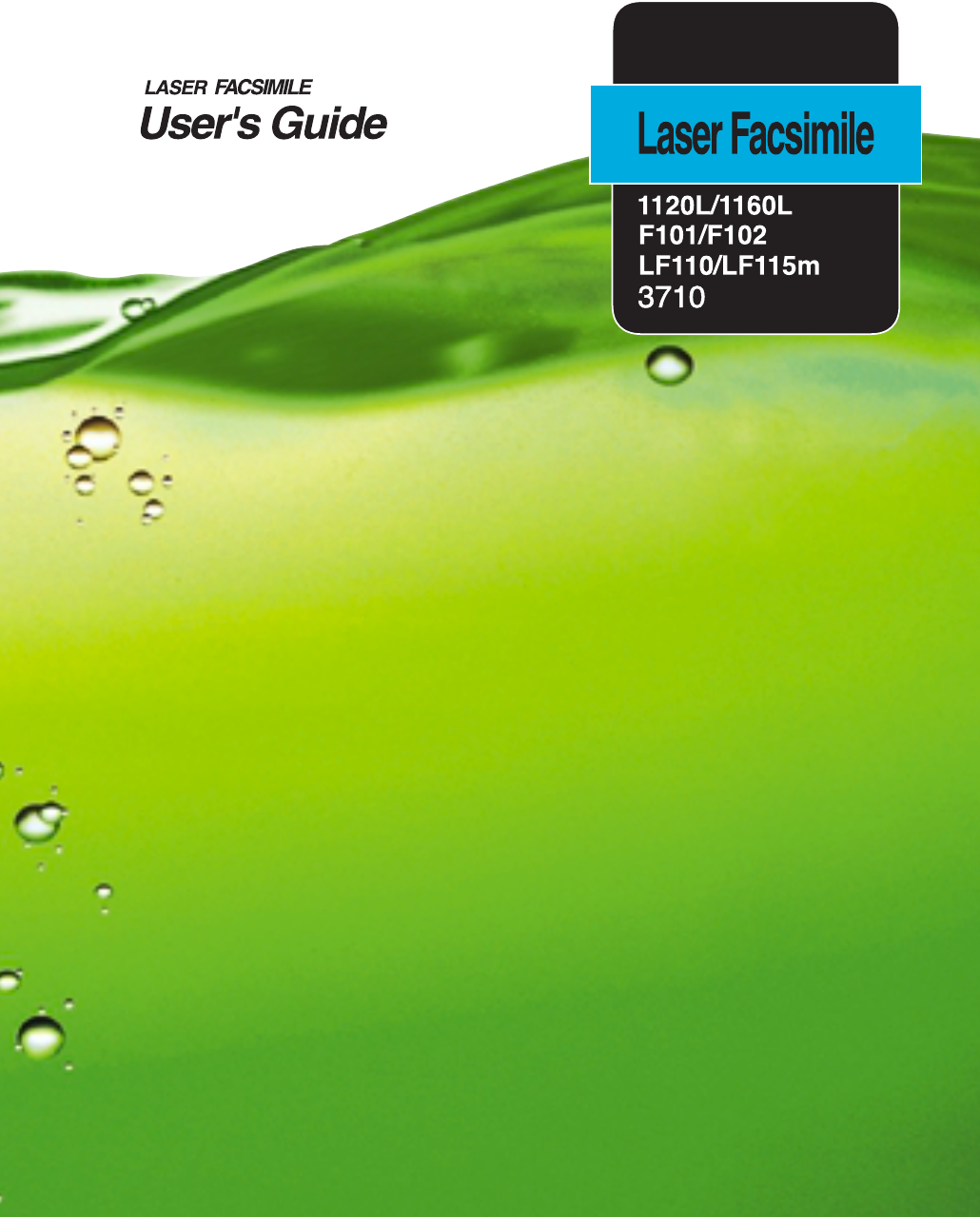
Trademarks
• Windows, Windows 95, Windows 98, Windows Me, Windows NT, Windows 2000
and Windows XP are trademarks of Microsoft corporation.
• Other names and trademarks mentioned in this manual are trademarks of their
respective holders.
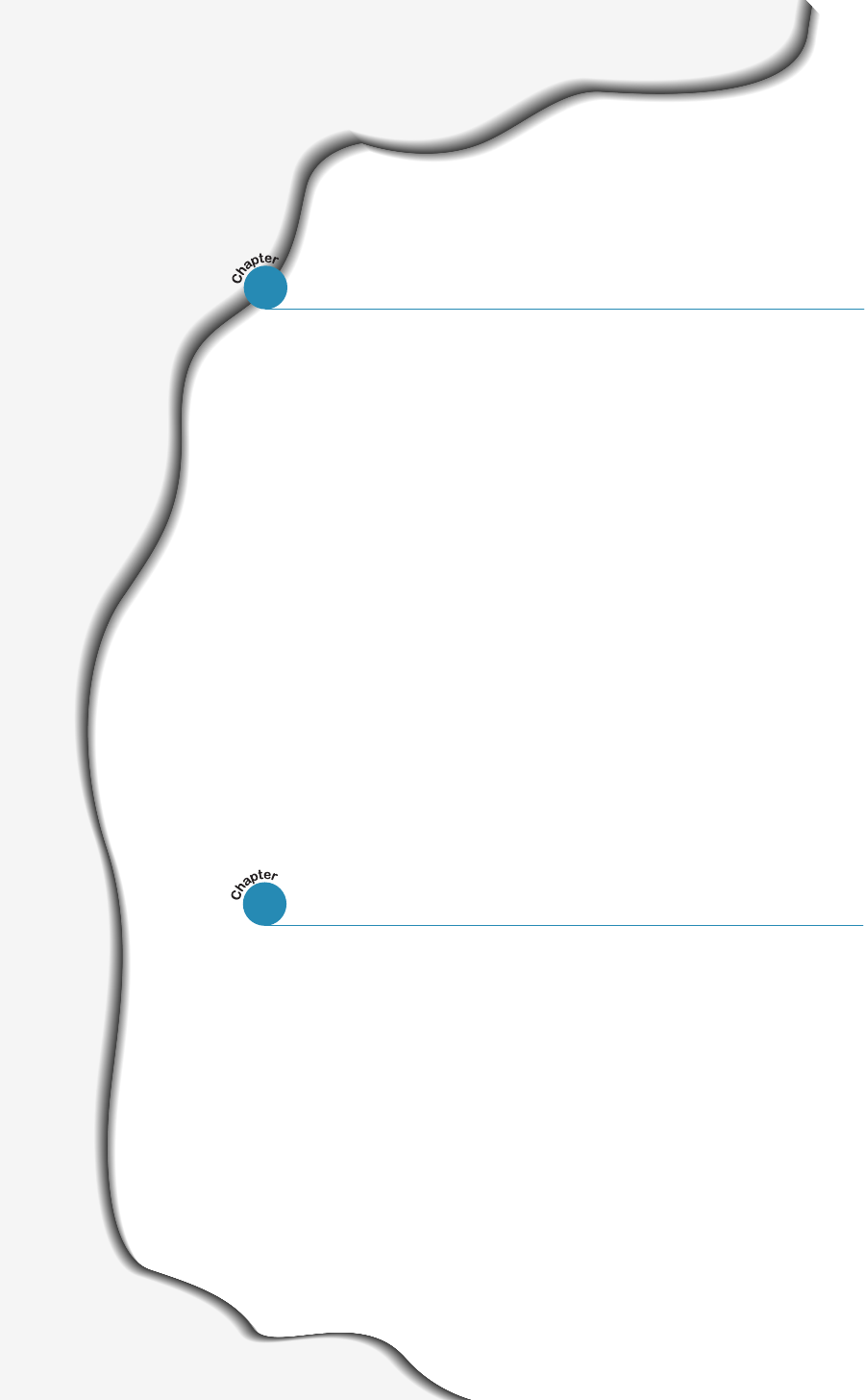
I
Introduction
Welcome! ––––––––––––––––––––––––––––––––––––––––– 1.1
Contents –––––––––––––––––––––––––––––––––––––––––– 1.3
Identifying Parts ––––––––––––––––––––––––––––––––––– 1.4
Setting Up Your Machine
Choosing a Location –––––––––––––––––––––––––––––––– 1.9
Preparing Your Machine for Use ––––––––––––––––––––– 1.9
Attaching the Supports –––––––––––––––––––––––––––– 1.10
Connecting to the Phone Line –––––––––––––––––––––– 1.11
Connecting to the Computer (MFP model only) –––––– 1.12
Plugging In the Power ––––––––––––––––––––––––––––– 1.13
Loading Paper –––––––––––––––––––––––––––––––––––– 1.13
Installing the Toner Cartridge –––––––––––––––––––––– 1.16
Setting the Date and Time ––––––––––––––––––––––––– 1.18
Setting Your Fax Number and Name –––––––––––––––– 1.19
Contents
Getting Started
Setting Up Stand-alone Fax System
Setting Volume –––––––––––––––––––––––––––––––––– 2.1
Setting Alert Tones ––––––––––––––––––––––––––––––– 2.2
Setting User-Selectable System Options –––––––––––––– 2.2
Sending a Fax
Preparing Documents for Faxing or Copying ––––––––––– 2.7
Setting Document Resolution and Contrast –––––––––––– 2.8
Loading Documents ––––––––––––––––––––––––––––––– 2.9
Sending a Fax Automatically ––––––––––––––––––––––– 2.10
Sending a Fax After Talking ––––––––––––––––––––––– 2.11
1
2
Stand-alone Fax

II
Receiving a Fax
About
Reception Modes –––––––––––––––––––––––––– 2.12
Loading Paper for Receiving Faxes
–––––––––––––––– 2.13
Receiving Automatically in FAX Mode –––––––––––––––– 2.13
Receiving in AUTO Mode –––––––––––––––––––––––––– 2.14
Receiving Automatically in ANS/FAX Mode –––––––––––– 2.14
Receiving Manually in TEL Mode –––––––––––––––––––– 2.15
Receiving Manually Using Remote Receive Start Code ––– 2.15
Making a Copy
Copying Overview ––––––––––––––––––––––––––––––– 2.16
Making a Single Copy –––––––––––––––––––––––––––– 2.16
Using Advanced Copy Features ––––––––––––––––––––– 2.17
Automatic Dialling
How To Enter a Name Using the Number Keys ––––––––– 2.18
One-Touch Dialling –––––––––––––––––––––––––––––– 2.20
Speed Dialling –––––––––––––––––––––––––––––––––– 2.22
Searching for a Number in the Memory –––––––––––––– 2.24
Transmission Options
Broadcasting ––––––––––––––––––––––––––––––––––– 2.25
Delayed Fax –––––––––––––––––––––––––––––––––––– 2.26
Priority Fax –––––––––––––––––––––––––––––––––––– 2.28
Polling –––––––––––––––––––––––––––––––––––––––– 2.29
Adding Documents To a Scheduled Operation ––––––––– 2.31
Cancelling a Scheduled Operation ––––––––––––––––––– 2.31
Additional Functions
Monitoring a Dual Job Status ––––––––––––––––––––––– 2.32
Forwarding Received Faxes –––––––––––––––––––––––– 2.32
Printing Reports ––––––––––––––––––––––––––––––––– 2.33
Group Dialling (for Multi-Address Transmission) ––––––––––– 2.35
Stand-alone Fax (continued)
2
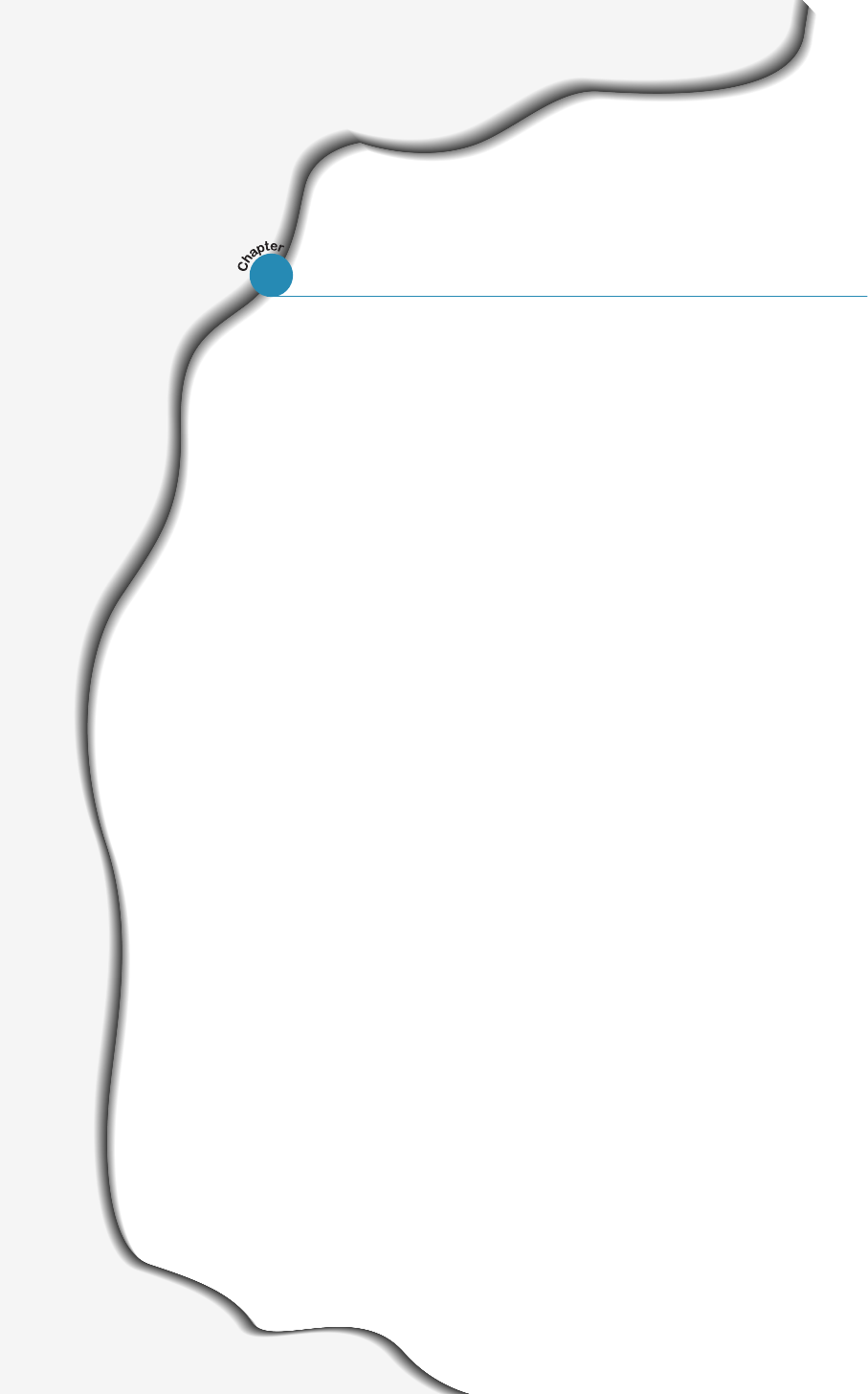
III
Contents (continued)
Installing Software
System Requirements –––––––––––––––––––––––––––––– 3.1
Installing the Software ––––––––––––––––––––––––––––– 3.1
Uninstalling the Software ––––––––––––––––––––––– 3.3
Print Media
Selecting Print Media ––––––––––––––––––––––––––––––– 3.5
Using the Automatic Paper Input Tray –––––––––––––––– 3.7
Using the Manual Paper Input Tray –––––––––––––––––– 3.9
Specialty Paper Guidelines ––––––––––––––––––––––––– 3.12
Printing
Printing a Document –––––––––––––––––––––––––––––– 3.13
Cancelling a Print Job ––––––––––––––––––––––––––––– 3.16
Printing Help ––––––––––––––––––––––––––––––––––––– 3.17
Printing Several Pages Per Sheet ––––––––––––––––––– 3.18
Scaling Your Document –––––––––––––––––––––––––––– 3.19
Fitting Your Document to a Selected Paper Size –––––– 3.20
Printing Posters ––––––––––––––––––––––––––––––––––– 3.21
Printing Watermarks –––––––––––––––––––––––––––––– 3.22
Using Page Overlays –––––––––––––––––––––––––––––– 3.24
Printing in a Network Environment ––––––––––––––––– 3.28
Scanning
Scanning from a Windows Application –––––––––––––– 3.30
Type1100 TWAIN for Scan Window ––––––––––––––––– 3.31
Printing and Scanning (MFP model only)
3
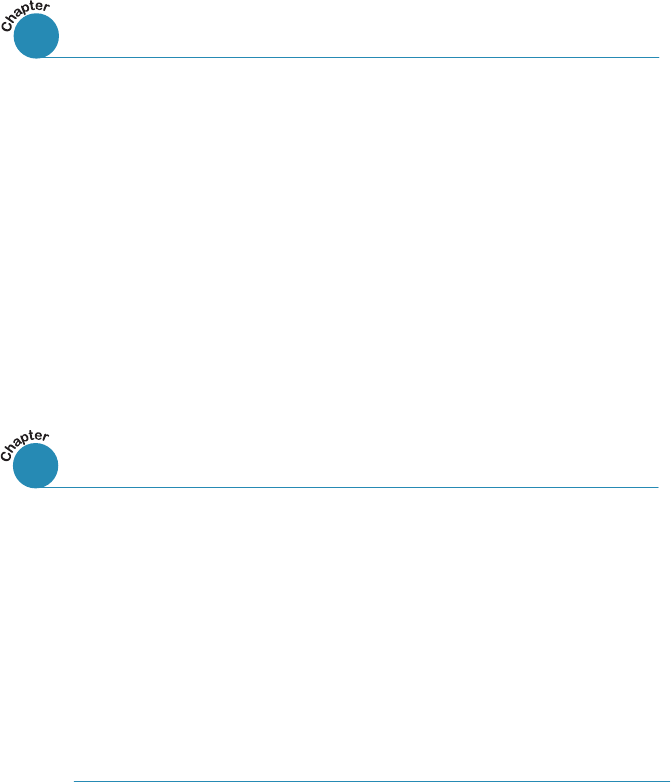
IV
Guidelines for Maintenance ––––––––––––––––––––––––– 4.1
Clearing Memory ––––––––––––––––––––––––––––––––––– 4.1
Cleaning the OPC Drum –––––––––––––––––––––––––––– 4.2
Adjusting Shading ––––––––––––––––––––––––––––––––– 4.2
Setting the Machine to be Checked by Phone ––––––––– 4.3
Sending Toner Low Information
to the Service Company ––––––––––––––––––––––––––––– 4.3
Cleaning the Machine –––––––––––––––––––––––––––––– 4.4
Managing the Toner Cartridge ––––––––––––––––––––––– 4.7
Automatic Document Feeder Rubber Pad Replacement 4.10
4
Maintenance
Clearing Paper Jams
––––––––––––––––––––––––––––––––––
5.1
LCD Error Messages
––––––––––––––––––––––––––––––––––
5.5
Fax Problems
––––––––––––––––––––––––––––––––––––––––
5.7
General Printing Problems (MFP model only)
––––––––––
5.9
Print Quality Problems
––––––––––––––––––––––––––––––
5.11
Troubleshooting
5
Connecting Other Devices to the Phone line
–––––––––––
A.1
Specifications
––––––––––––––––––––––––––––––––––––––––
A.4
Safety Information
–––––––––––––––––––––––––––––––––––
A.6
Index
––––––––––––––––––––––––––––––––––––––––––––––
A.13
Appendix
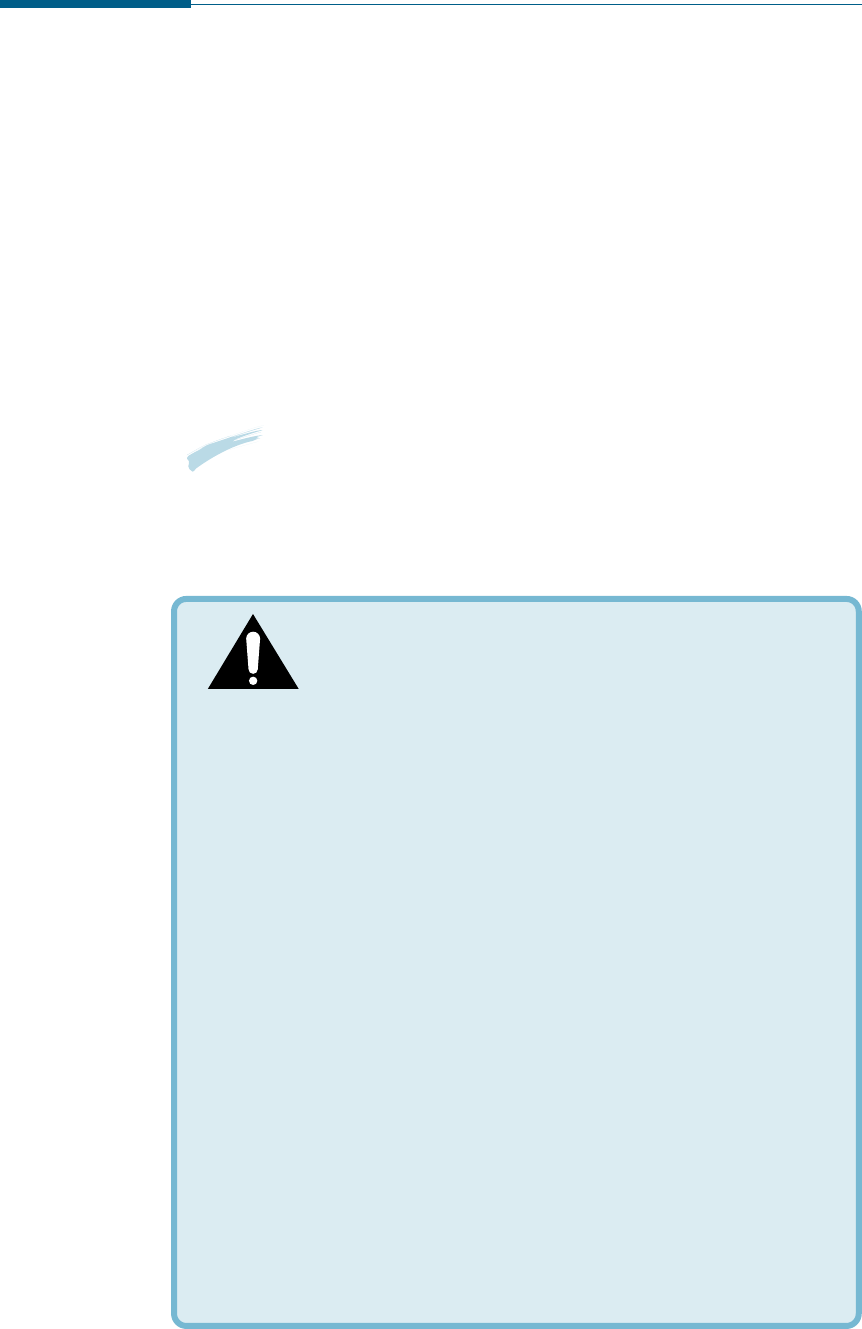
CAUTION - INVISIBLE LASER RADIATION WHEN
THIS COVER OPEN. DO NOT OPEN THIS
COVER.
VORSICHT - UNSICHTBARE LASERSTRAHLUNG, WENN ABDECKUNG
GEÖFFNET. NICHT DEM STRAHL AUSSETZEN.
ATTENTION - RAYONNEMENT LASER INVISIBLE EN CAS
D’OUVERTURE.EXPOSITION DAN GEREUSE AU
FAISCEAU.
ATTENZIONE -RADIAZIONE LASER INVISIBILE IN CASO DI
APERTURA.
EVITARE L’ESPOSIZIONE AL FASCIO.
PRECAUCION -RADIACION LASER IVISIBLE CUANDO SE ABRE.
EVITAR EXPONERSE AL RAYO.
ADVARSEL - USYNLIG LASERSTRÅLNING VED ÅBNING NÅR
SIKKERHEDSBRYDERE ER UDE AF FUNKTION. UNDGÅ
UDSAETTELSE FOR STRÅLNING.
ADVARSER - USYNLIG LASERSTRÅLNING NÅR DEKSEL ÅPNES.
STIRR IKKE INN I STRÅLEN. UNNGÅ EKSPONERING
FOR STRÅLEN.
VARNING - OSYNLIG LASERSTRÅLNING NÄR DENNA DEL ÄR
ÖPPAND OCH SPÄRREN ÄR URKOPPLAD. BETRAKTA EJ
STRÅLEN. STRÅLEN ÄR FARLIG.
VARO! - AVATTAESSA JA SUOJALUKITUS OHITETTAESSA OLET
ALTTIINA NÄKYMÄTTÖMÄLLE LASERSÄTEILYLLE ÄLÄ
KATSO SÄTEESEEN.
Environmental and Safety Consideration
Laser Safety Statement
The printer is certified in the U.S. to conform to the
requirements of DHHS 21 CFR, chapter 1 Subchapter J for Class
I(1) laser products, and elsewhere is certified as a Class I laser
product conforming to the requirements of IEC 825.
Class I laser products are not considered to be hazardous. The
laser system and printer are designed so there is never any
human access to laser radiation above a Class I level during
normal operation, user maintenance, or prescribed service
condition.
CAUTION: Use of controls or adjustment or performance of
procedures other than those specified in this manual
might result in hazardous radiation exposure.
WARNING
Never operate or service the printer with the protective cover removed
from Laser/Scanner assembly. The reflected beam, although invisible, can
damage your eyes.
V
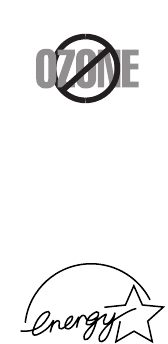
Ozone Safety
During normal operation, this machine produces ozone. the ozone
produced does not present a hazard to the operator. However, it is
advisable that the machine be operated in a well ventilated area.
If you need additional information about ozone, please request
your nearest dealer.
Power Saver
This printer contains advanced energy conservation technology
that reduces power consumption when it is not in active use.
When the printer does not receive data for an extended period of
time, power consumption is automatically lowered.
The energy star emblem does not represent EPA endorsement of
any product or service.
Radio Frequency Emissions
FCC Regulations
This equipment has been tested and found to comply with the
limits for a Class B digital device, pursuant to Part 15 of the FCC
Rules. These limits are designed to provide reasonable protection
against harmful interference in a residential installation. This
equipment generates, uses and can radiate radio frequency energy
and, if not installed and used in accordance with the instructions,
may cause harmful interference to radio communications.
However, there is no guarantee that interference will not occur in a
particular installation.
If this equipment does cause harmful interference to radio or
television reception, which can be determined by turning the
equipment off and on, the user is encouraged to try to correct the
interference by one or more of the following measures:
• Reorient or relocate the receiving antenna.
• Increase the separation between the equipment and receiver.
• Connect the equipment into an outlet on a circuit different from
that to which the receiver is connected.
• Consult the dealer or an experienced radio/TV technician for
help.
Do not make any changes or modifications to the equipment
unless otherwise specified in the manual. If such changes or
modifications should be made, you must first stop operation of the
equipment.
Use of shielded cable is required to comply with Class B limits in
Subpart B of Part 15 of FCC Rules.
CAUTION: Changes or modifications not expressly approved by the
manufacture responsible for compliance could void the
user’s authority to operate the equipment.
VI

Canadian Radio Interference Regulations
This digital apparatus does not exceed the Class B limits for
radio noise emissions from digital apparatus as set out in the
interference-causing equipment standard entitled “Digital
Apparatus”, ICES-003 of the Industry and Science Canada.
Cet appareil numérique respecte les limites de bruits
radioélectriques applicables aux appareils numériques de Classe
B prescrites dans la norme sur le matériel brouilleur: “Appareils
Numériques”, ICES-003 édictée par l’Industrie et Sciences
Canada.
DDeeccllaarraattiioonn ooff CCoonnffoorrmmiittyy
Notice to Users in EEA Countries
This product complies with the essential requirements and
provisions of Directive 1999/5/EC of the European Parliament
and of the Council of 9 March 1999 on radio equipment and
telecommunications terminal equipment and the mutual
recognition of their conformity.
Notice to Users Accessing Analog PSTN
in EEA Countries
This product is designed to be able to access analog PSTN in all
EEA countries. Local PSTN compatibility is dependent on
software switch settings. Please contact your service
representative if relocating this product to another country. In
the event of problems, please contact your service
representative in the first instance.
Ricoh: The CE Decalration of Conformity is available on the
Internet at URL: http://www.ricoh.co.jp/fax/ce_doc/
NRG: The CE Declaration of Conformity is available on the
Internet at URL: http://www.ricoh.co.jp/fax/ce_doc/
LANIER: The CE Declaration of Conformity is available by
accessing the URL: http://www.lanier-europe.com
VII
VIII
Memo
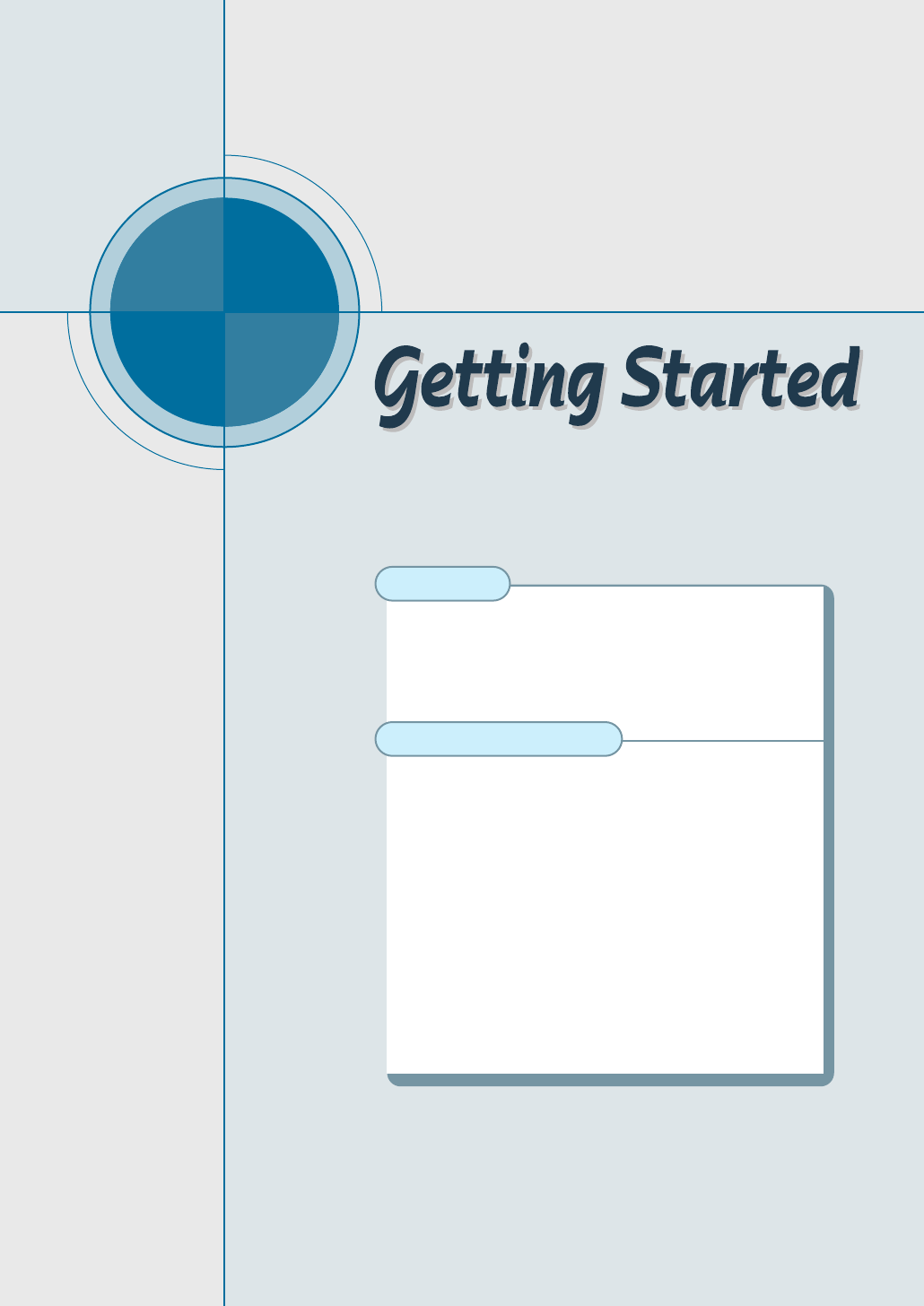
chapter
1
1
This chapter provides information on the following topics:
Introduction
◆ Welcome!
◆ Contents
◆ Identifying Parts
Setting Up Your Machine
◆ Choosing a Location
◆ Preparing Your Machine for Use
◆ Attaching the Supports
◆ Connecting to the Phone Line
◆ Connecting to the Computer (MFP model only)
◆ Plugging In the Power
◆ Loading Paper
◆ Installing Toner Cartridge
◆ Setting the Date and Time
◆ Setting Your Fax Number and Name
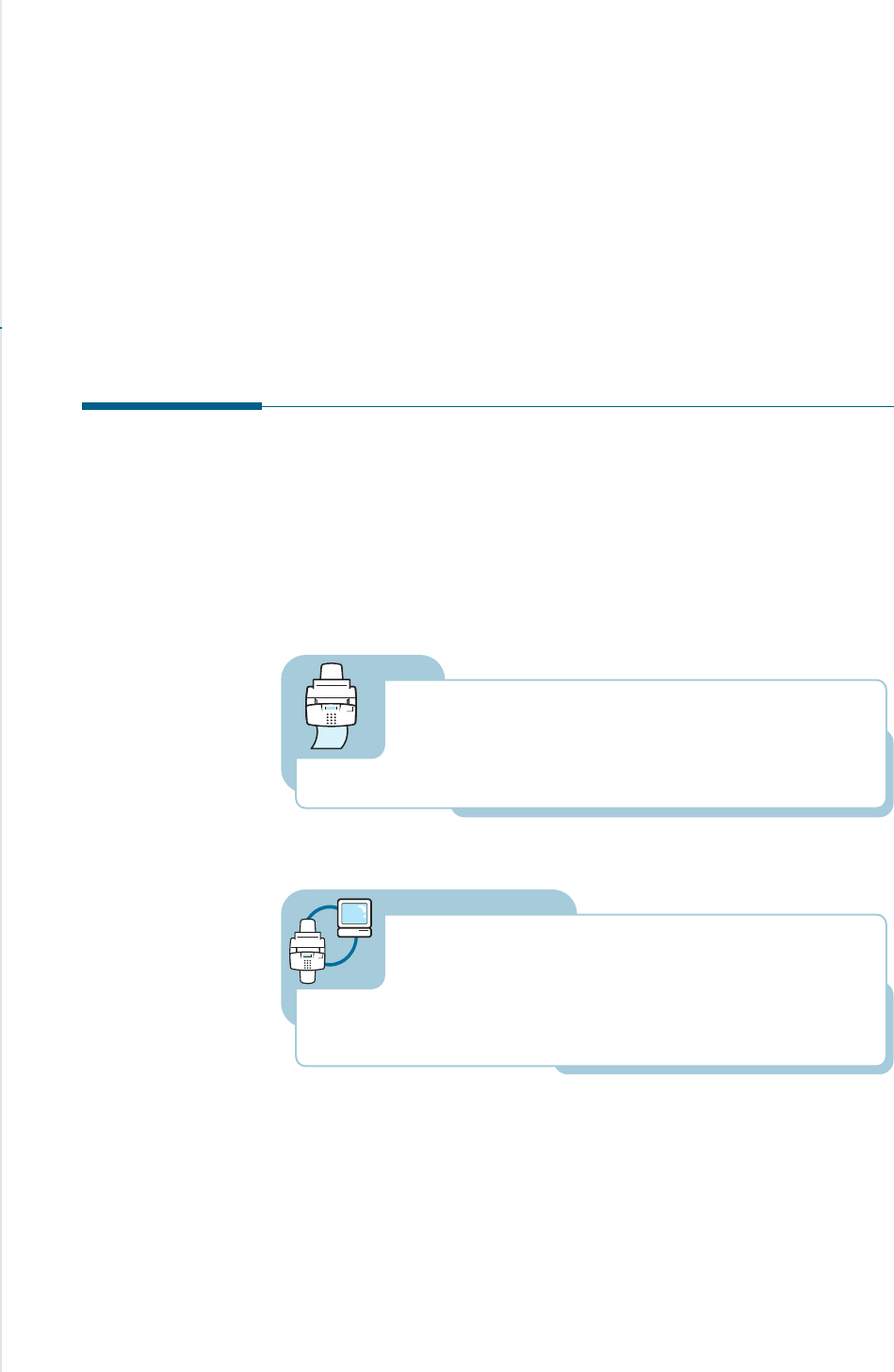
1.1
Getting Started
Welcome!
Thank you for purchasing this product, a powerful business tool with the
capabilities of a full range of office equipment. With this machine, you
can:
Introduction
You can get 600 x 600 dpi high-quality laserjet printing
from this machine. You can create professional documents
using the creative printing features on the various kinds of
print media, such as plain papers, envelopes,
transparencies, label, and so on.
Print (MFP model only)
Use this product as a full-featured stand-alone fax
machine to send and receive faxes. Perform advanced
tasks such as delayed transmission, broadcasting, and
unattended memory sending.
Fax
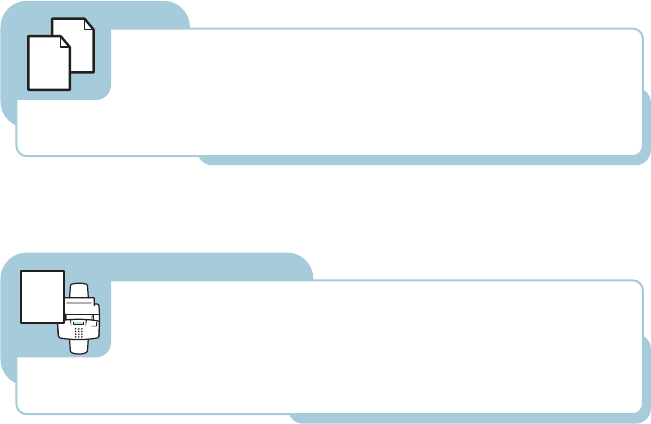
1.2 Getting Started
Make up to 99 copies of a 20-pages document without
having to connect to a PC. You can adjust the contrast,
enlarge or reduce the copies and collate.
A
A
Copy
Scan important documents to create electronic files. Use
the scanner to add photo or graphic images to other
software applications or to jazz up your projects.
Scan (MFP model only)
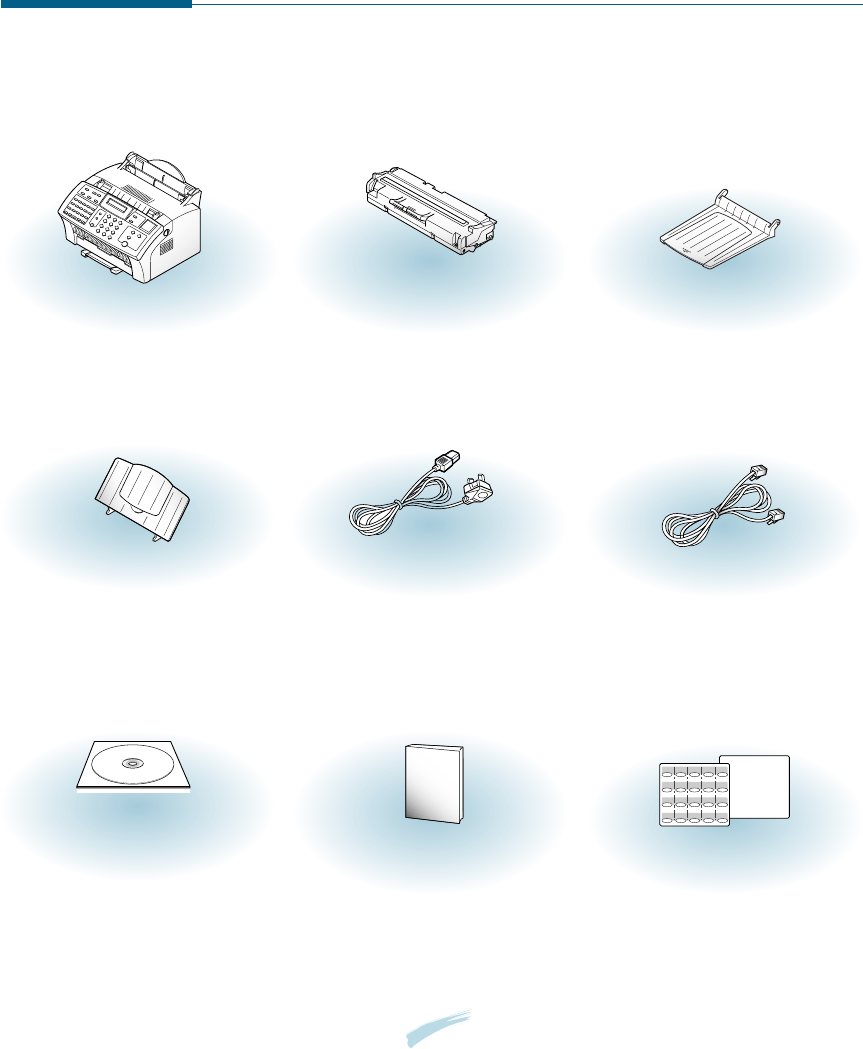
1.3
Getting Started
Document output support
Document input support Power cord *Telephone line cord *
software CD-ROM
(for MFP model only) User’s Guide One-touch label for the front panel
and a panel sheet (for Europe only)
Contents
Here’s what comes with this machine.
Toner cartridge
Fax machine
*
: These may look different depending on the country.
Notes:
•
You should use the Telephone line cord which is supplied with the
machine. If you are replacing it with the other vendor’s part, it
should be AWG #26 or lower gage.
•
Power cord must be plugged in grounded power socket.
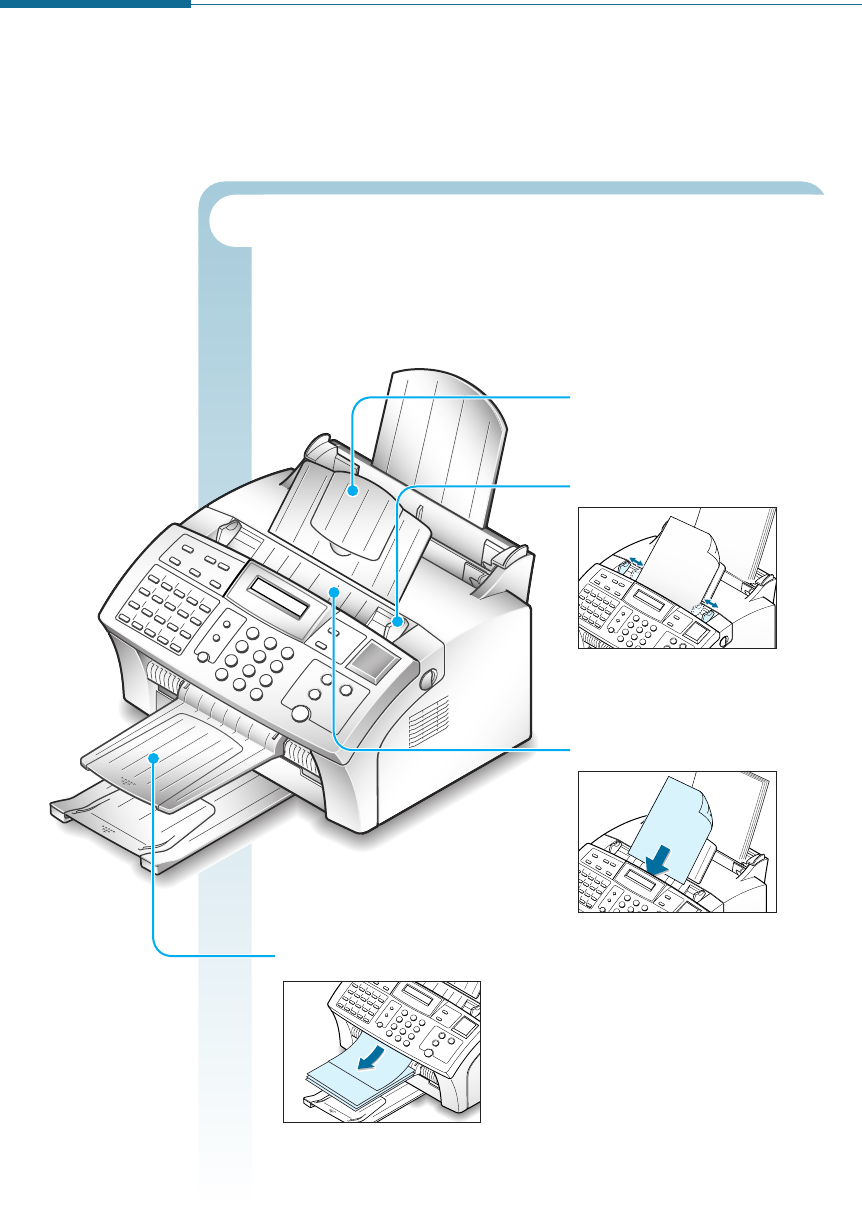
1.4 Getting Started
Identifying Parts
Before setting up your machine, make sure you identify the following
parts related to the scanner and paper print paths.
Document input support
Supports original documents.
Aligns documents.
Loads up to 20 pages at a time.
Supports the original document
when faxing, copying, or
scanning is complete.
Document guides
Automatic document feeder
Document output support
Identifying Scanner Path Parts
Items to be faxed, copied, or scanned use the scanner path
which consists of the following parts:
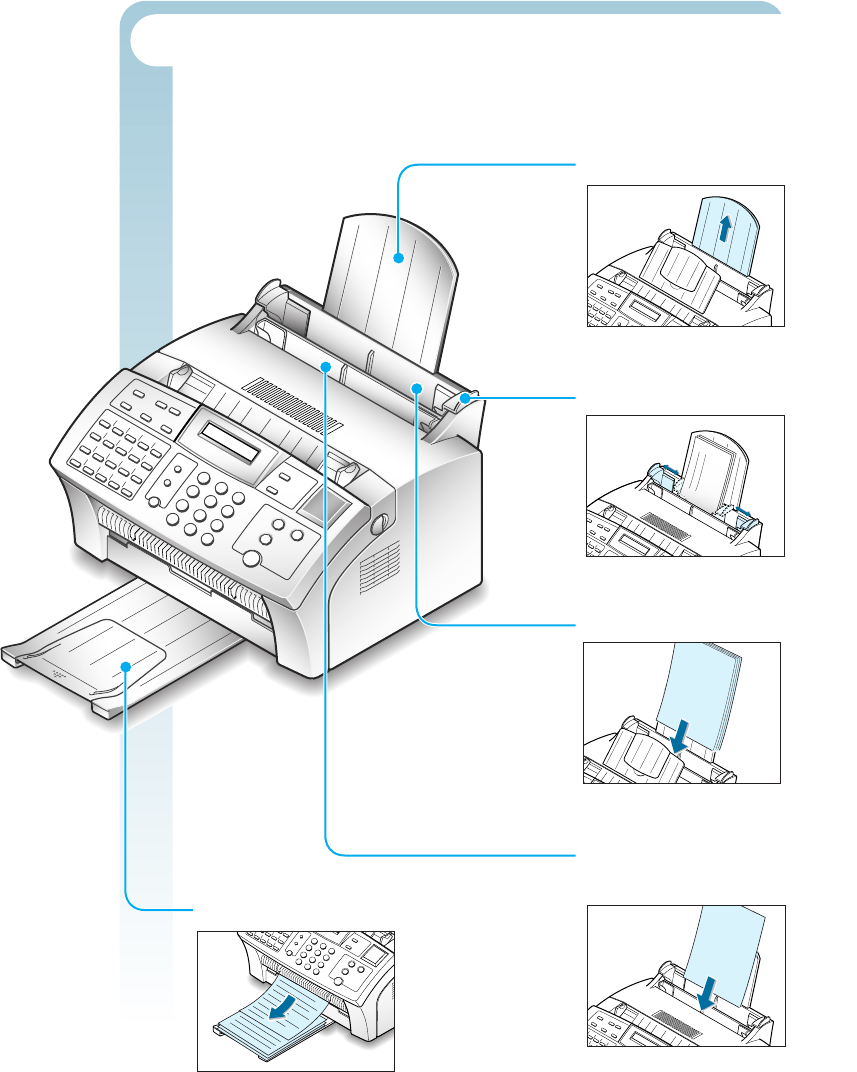
1.5
Getting Started
Identifying Printer Path Parts
Paper for printing, receiving faxes and copying follow the printer
path. This path consists of the following parts:
Use to feed paper one
sheet at a time.
Supports the printed pages.
Holds paper.
Aligns paper.
Manual paper input tray
(For MFP model only)
Support the print media
Paper input support
Paper output tray
Automatic paper input tray
Paper guides
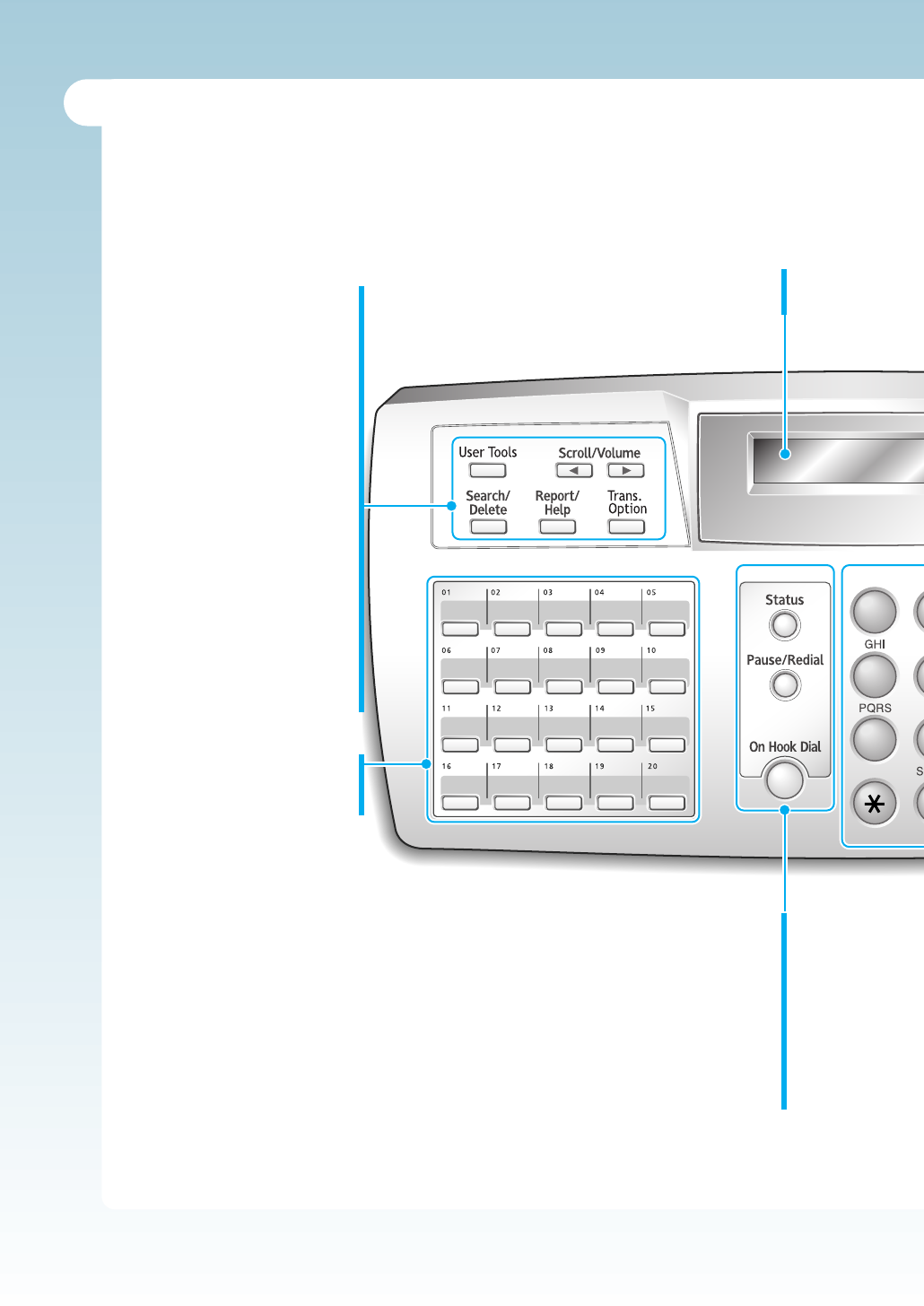
1.6 Getting Started
01 02 03 04 05
16 17 18 19
11 12 13 14 15
20
06 07 08 09 10
GHI
PQRS
Sy
Demo
1
4
7
Identifying Front Panel Features
Look for the following keys and features on the front panel. These features are used to
fax documents, make copies, and adjust settings.
User Tools
Use to set up various system
options.
Scroll/Volume
Use to scroll the menu items or us
to move the cursor left or right
through the display. Also, use to
adjust the ringer volume.
Search/Delete
Use to search for a number in
memory or to delete the last digit
when typing text.
Report/Help
Use to print various reports and
the help list.
Trans. Option
Use to access advanced fax
operations.
Twenty One-Touch Buttons
Store frequently dialled fax
numbers.
LCD Display
Displays messages and menu settings.
Status
Use to switch the display status while
performing dual jobs.
Pause/Redial
Use to redial the last fax number or to
insert a pause into a fax number.
On Hook Dial
Use to dial numbers without picking up
the handset. Also, use to make a voice
call after sending or receiving a fax.
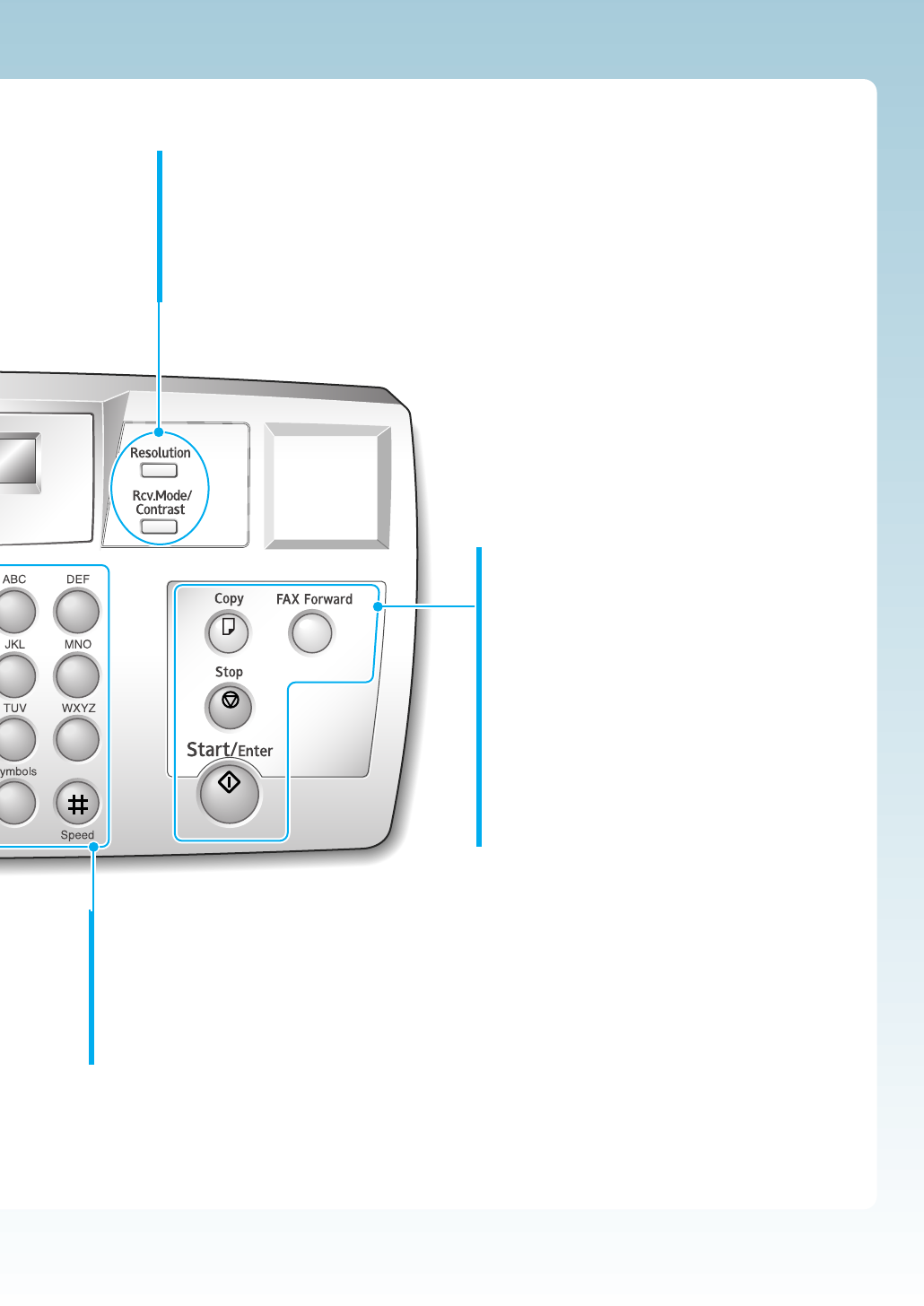
1.7
Getting Started
Rcv. Mode/Contrast
When a document is loaded, choose the contrast characteristic of copied
or transmitted documents.
When a document is not loaded, choose the receive mode to use.
The selected mode is displayed in Standby mode.
Resolution
Choose the resolution of documents.
Number Keypad
Use to enter fax numbers manually or to
enter letters.
Speed(#)
Use to send documents by entering a
registered 2-digit number.
Fax Forward
Allows you to forward the received faxes to
the defined remote fax machine at a specified
duration.
Copy
Makes a copy of a document.
Start/Enter
Starts a job. Also use to activate the selection
shown on the display.
Stop
Stops an operation at any time.
JKL MNO
TUV WXYZ
ymbols
Speed
Rcv. Mode/
Contrast
Resolution
23
56
0
89
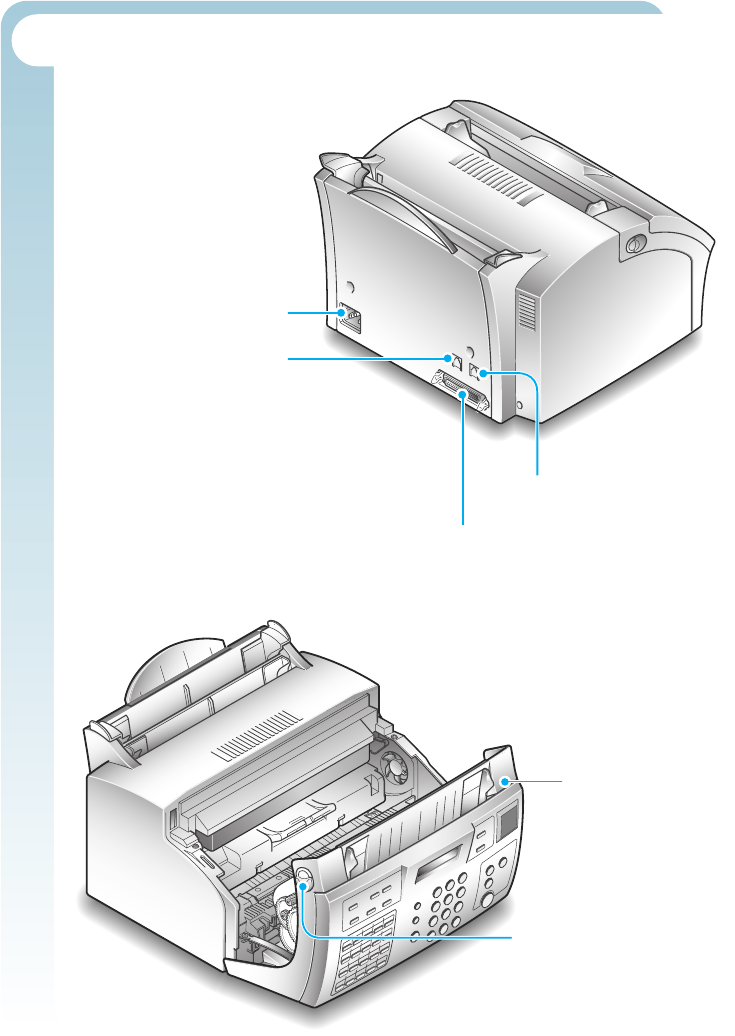
1.8 Getting Started
Identifying Connecting Parts and Others
Power cord connector
Telephone line jack
Extension telephone jack
Cover
Cover release
buttons (right and left)
Parallel cable connector
(MFP model only)
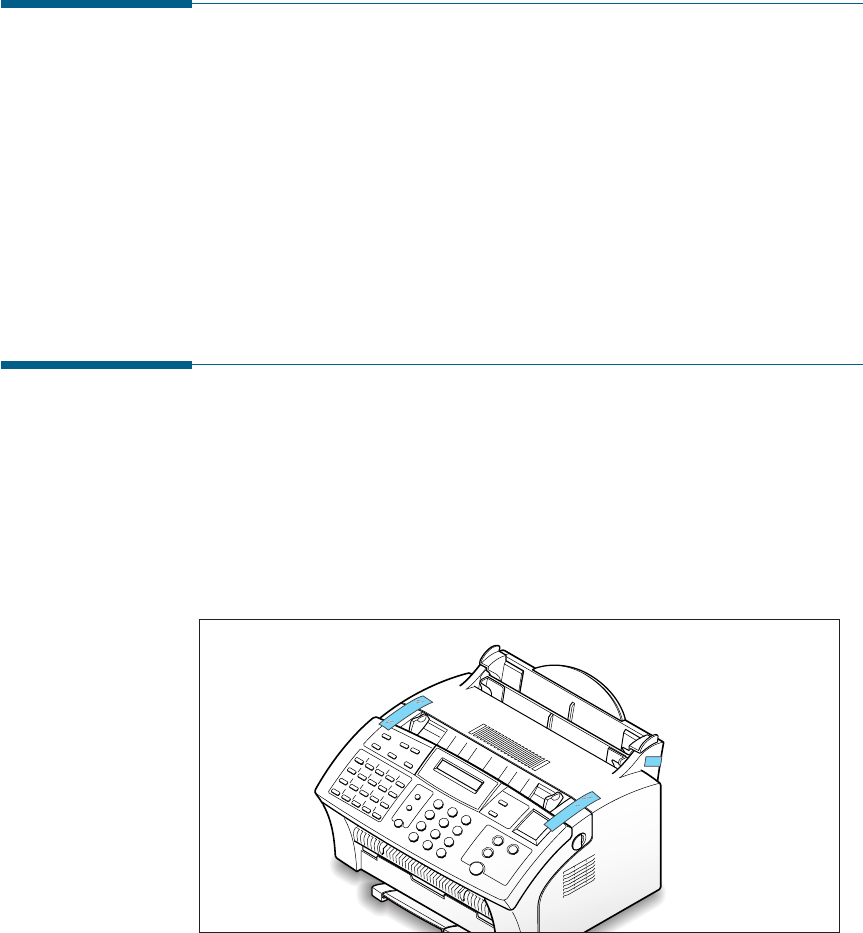
1.9
Getting Started
Choosing a Location
For the trouble-free operation of your machine, place it on a flat, stable
surface near your workstation. Leave enough space to allow for easy
paper loading and exiting, as well as opening the front cover.
Do not place your machine:
• In direct sunlight.
• Near heat sources or air conditioners.
• In a dusty or dirty environment.
Preparing Your Machine for Use
When you take this machine out the box, note that it has been packaged
to protect it during shipping. Before you use the machine, make certain
that you check for the following items:
• Remove all tapes.
• Remove all packing materials.
Setting Up
Your Machine
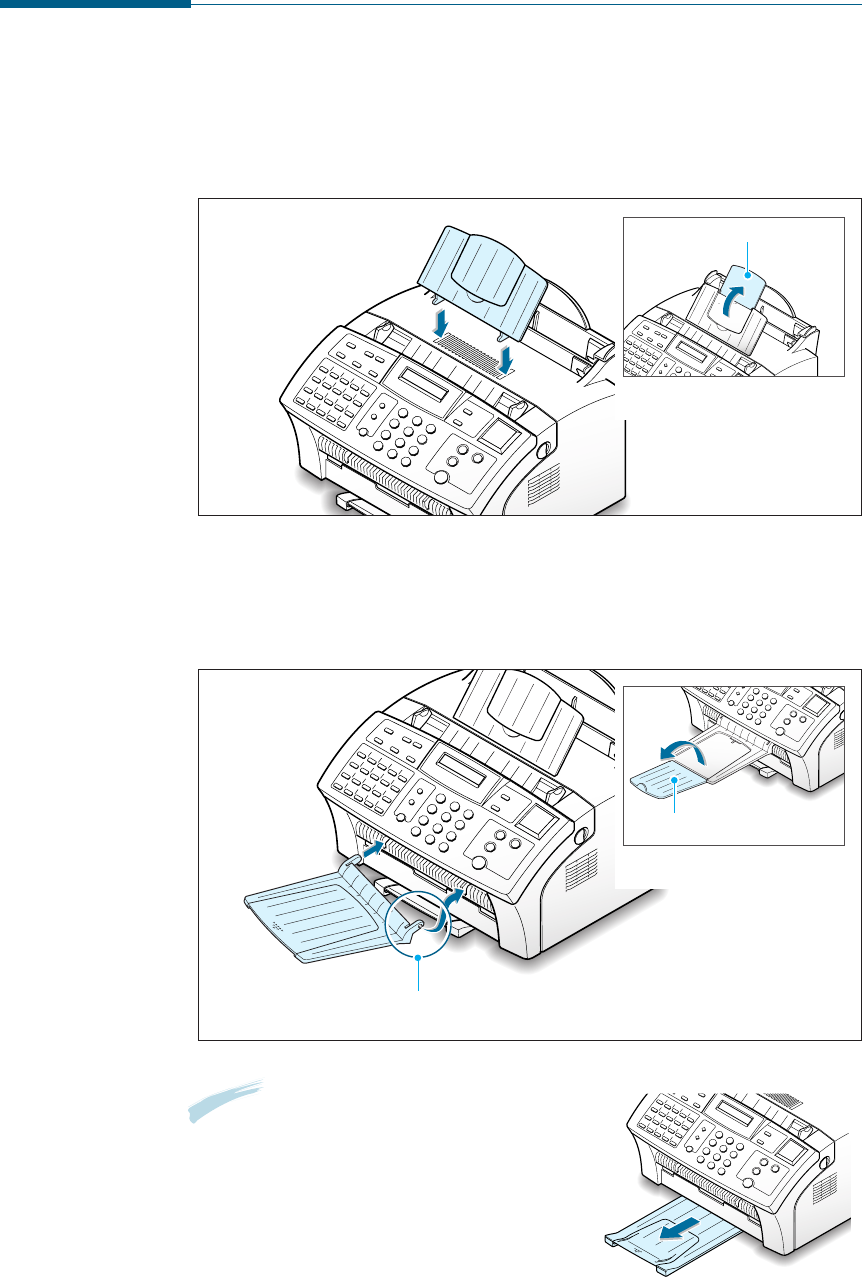
1.10 Getting Started
Attaching the Supports
Document Input Support
Insert the document input support with the groove pointing to the rear
top of the machine.
Document Output Support
Insert the two tabs on the document output support into the slots on the
front of your machine.
Note: This machine is shipped with the paper
output tray already installed. Extend
the tray to use.
Fold out the extender if necessary.
Extender
Fold out the extender if
necessary.
Insert one end first, then the other end by squeezing this
leg inward to make the tray easy to insert.
Extender
Fold out the extender if
necessary.
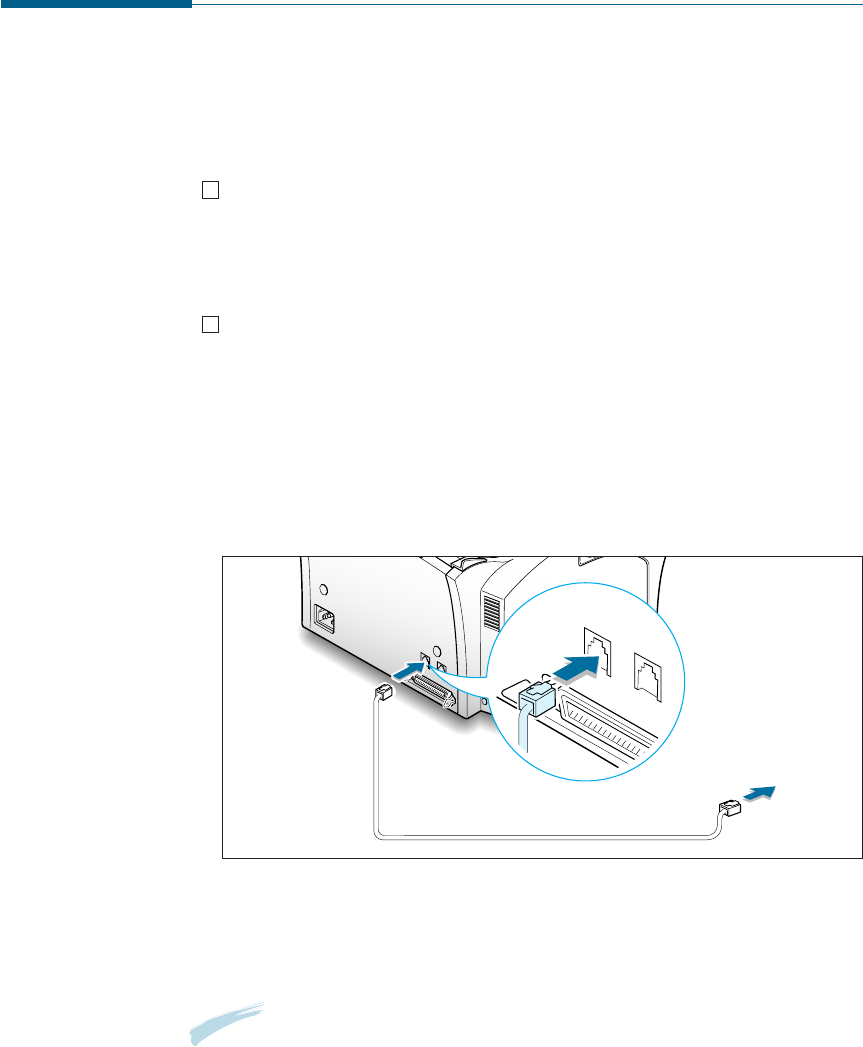
1.11
Getting Started
Connecting to the Phone Line
For proper operation, this machine must be connected to the wall jack.
Once you have decided which wall jack you will be using, check a box
below and follow the instructions.
I only have one phone line coming to this wall jack. (This
includes two phone numbers on one line with distinctive ring service.)
Go to “To Connect to a Wall Jack that Has Only One Phone Line” on
this page.
I have two phone lines coming to this wall jack. Go to “To
Connect to a Wall Jack that Has Two Phone Lines” on page 1.12.
LINE EXT.
To a standard
phone wall jack
To Connect to a Wall Jack that has Only One Phone Line
1. Plug the included telephone cord into the jack on the back of the unit
marked the word LINE.
2. If a telephone cord is plugged into the wall jack, unplug the cord and
set it aside.
3. Plug the other end of the phone cord into the wall jack.
Notes:
• If you are connecting other devices such as a telephone to the phone
line, go to Appendix “Connecting Other Devices To the Phone Line” on
page A.1.
• If you are not connecting other devices, go to “Plugging In the Power”
on page 1.13.
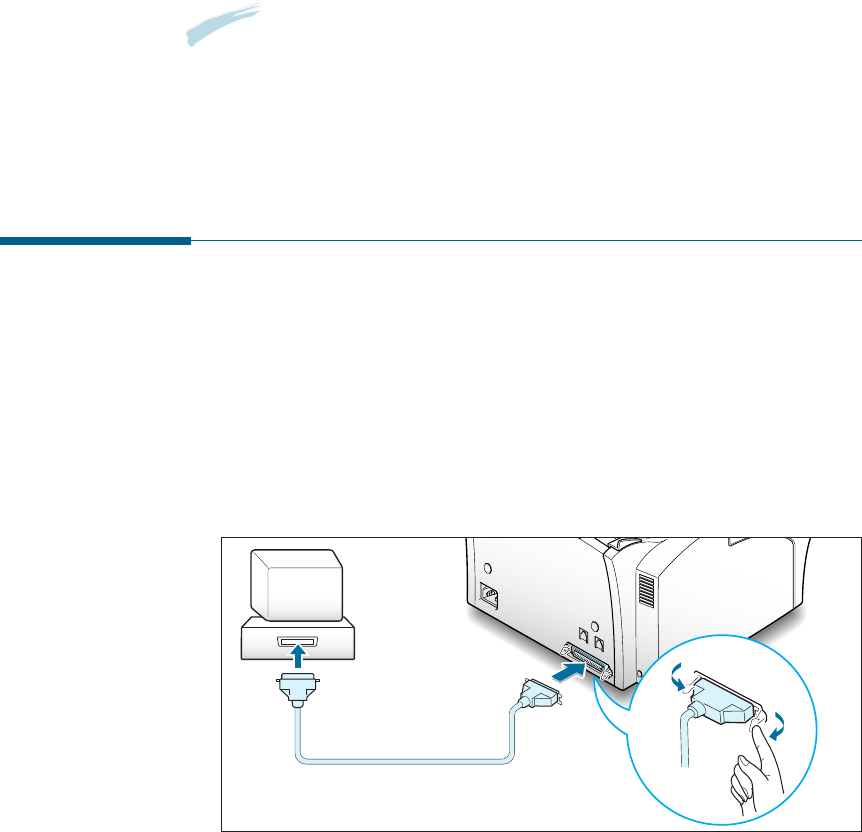
1.12 Getting Started
To Connect to a Wall Jack that Has Two Phone Lines
1. Plug the included telephone cord into the jack on the back of the unit
marked the word LINE.
2. If a telephone cord is plugged into the wall jack, unplug it and set it
aside.
3. If you do not have a wall jack that has a built-in splitter, plug a phone
unit splitter (not included) into the wall jack.
4. Plug the cord into the side of the phone unit splitter for the fax
number.
Notes:
• If you are connecting other devices such as a telephone to the same
phone line, go to Appendix “Connecting Other Devices To the Phone
Line” on page A.1.
• If you are not connecting other devices, go to “Plugging In the Power”
on page 1.13.
Connecting to the Computer (MFP model only)
Your machine has a parallel port which allows use with a Windows PC.
Connecting to the Computer Using the Parallel interface
1. Plug the supplied parallel printer cable into the connector on the back
of your machine. Push the metal clips down to fit inside the notches
on the cable plug.
2. Connect the other end of the cable to the parallel interface port on
your computer. See your computer documentation for more
information.
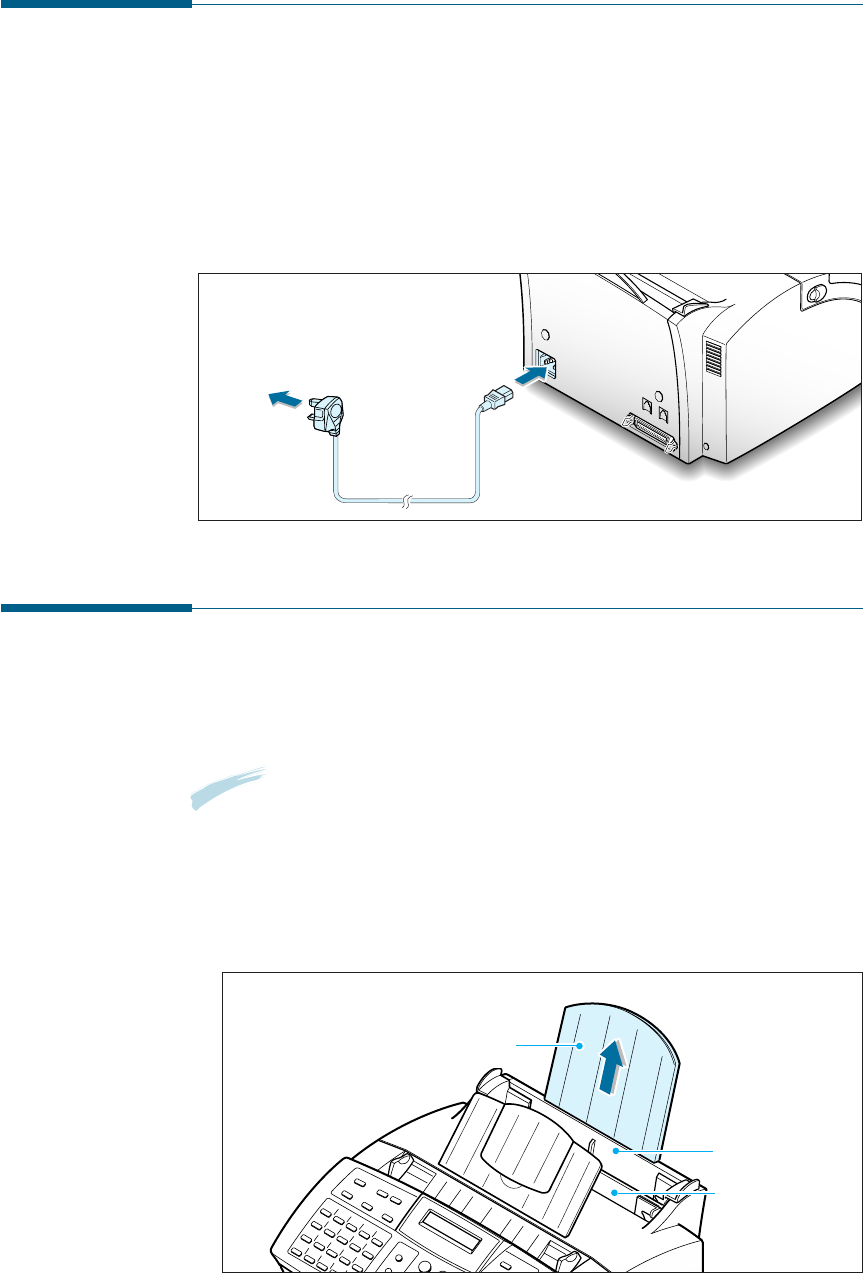
1.13
Getting Started
Loading Paper
For best results, use high quality xerographic paper. The automatic paper
input tray can hold a maximum of 150 sheets of plain paper. The
maximum capacity may be less, depending on the paper thickness.
Note: For stand-alone copy and fax operations, this machine supports A4,
letter, and legal paper. After loading paper, make sure that you
select the correct paper size. For more information on setting the
paper size, see ‘Setting User-Selectable System Options’ on page
2.2.
1. Pull the paper input support completely out of the unit.
Paper input support
Automatic paper
input tray
Manual paper
input tray only
for MFP model.
Plugging In the Power
Plug one end of the cord into the back of the machine and the other end
into a standard AC power outlet.
This machine will turn on and the display will show ‘SYSTEM INITIAL’. If
there is no paper loaded, the displays will shows ‘NO PAPER.’ then if
there is no cartridge installed, the display will show ‘JAM/NO
CARTRIDGE’.
To AC outlet
To turn off, unplug the power cord.
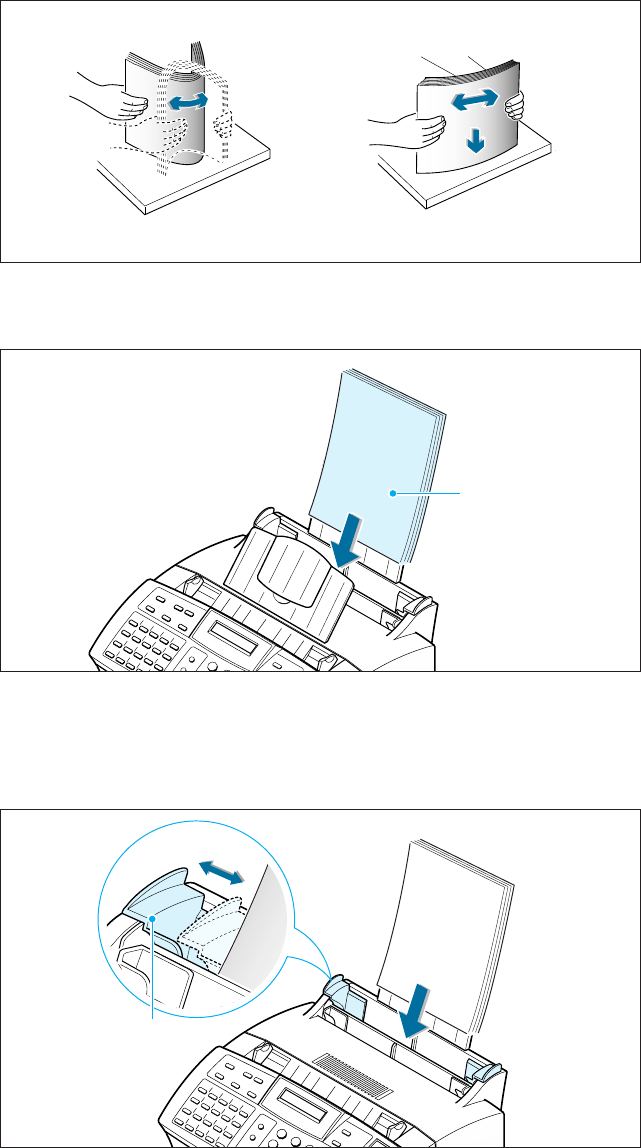
1.14 Getting Started
2. Remove a stack of paper from its packaging. Tap the stack on a flat
surface to even it up.
4. Adjust the paper guides to the width of the print media. Slide the
guides until they lightly touch the stack of print media. Do not bend
the print material.
Paper guide
3. Insert the paper with the print side facing you.
Place the print side
facing you.
1.15
Getting Started
Paper Type and Size
Satisfactory print and receive quality can be obtained with many types of
plain paper. Since the quality of plain paper varies widely, test the print
quality before buying large quantities of paper. Your machine uses a
variety of papers including:
• Xerographic paper
• Bond paper
• Dual-purpose paper
Because all papers vary in physical characteristics, you can receive
mixed results from different packages of paper even through the
packages contain the same paper. If you encounter undesirable results,
try the other side of the paper, a different type, or another package of
the same kind of paper.
DO NOT use the following types of paper with your machine:
• Continuous form feed paper
• Synthetic paper
• Thermal paper
• Multi-sheet forms and documents
• Chemically treated paper
• Papers with raised, embossed lettering
To load paper with a preferred print side:
• If you are using xerographic paper, load the paper with the preferred
print side facing down.
• If you are using letterhead or bond paper, load the paper with the
preferred side facing up.
The following papers can be used in your machine for fax:
• Letter : 216 x 279 mm (8.5 x 11.0 in.) - 60 g/m2~ 90 g/m2(16 ~ 24 lb)
• A4 : 210 x 297 mm (8.3 x 11.7 in.) - 60 g/m2~ 90 g/m2(16 ~ 24 lb)
• Legal : 216 x 356 mm (8.5 x 14.0 in.) - 60 g/m2~ 90 g/m2(16 ~ 24 lb)

1.16 Getting Started
Installing the Toner Cartridge
1. Pulling the cover release buttons found on both sides of the machine
toward you, open the cover.
2. Unpack the cartridge from its plastic bag, and then remove the paper
rolled the cartridge.
3. Shake the cartridge from side to side 5 or 6 times to redistribute the
toner evenly inside the cartridge.

1.17
Getting Started
4. Find the cartridge slots inside the machine, one on each side.
6. Close the cover. Make sure that the cover is securely closed.
5. Grasp the handle at the front of the cartridge and slide it down
between the cartridge slots, and push it firmly.
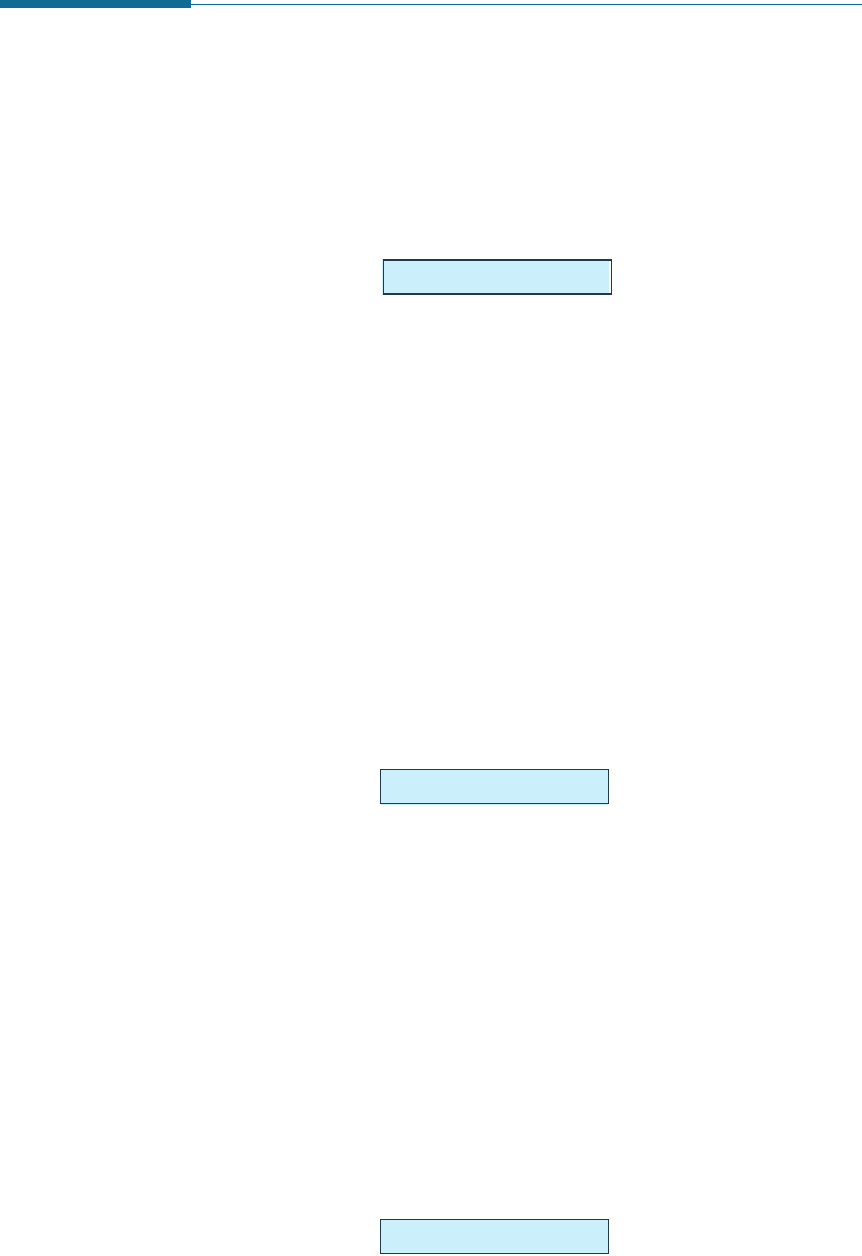
1.18 Getting Started
Setting the Date and Time
The current date and time are shown on the display when the machine is
on and ready for use (Standby mode). The date and time are printed on
all transmitted faxes.
When you install this series for the first time, or when the product is
without power for about 15 seconds, the display prompts you to reset the
date and time.
1. Press User Tools on the front panel. the display shows the first setup
menu; FAX NUMBER/NAME.
2. Press ➛or ❿until ‘TIME/DATE SETUP’ appears, then press
Start/Enter to access the Time/Date Setup menu.
3. The display asks you to choose a date format. Press Start/Enter.
4. Press ➛or ❿until you find the desired date format, then press
Start/Enter.
If you select USA, the date appears in format of Month-Day-Year. The
EUROPE format will be displayed in format of Day-Month-Year.
The display shows the currently set date and time using the selected
date format and asks you to set the month.
5. Enter the correct date and time for each item using the number keypad.
Each time you enter the appropriate number, the display asks you to
enter the next item in the following order: MONTH, DATE, YEAR, HOUR,
and MINUTE.
Enter the time in 24-hour format. For example, enter 2230 for 10:30
P.M.
If you enter an invalid number, the display does not proceed to the next
step. If this happens, re-enter the correct number.
6. When you are finished, press Start/Enter to save the setting. The
display returns to Standby mode and shows the date and time you have
set.
SET DATE & TIME
04-01-2001 10:30
19-MAR 12:30 FAX
(USA Format)
(EUROPE Format)
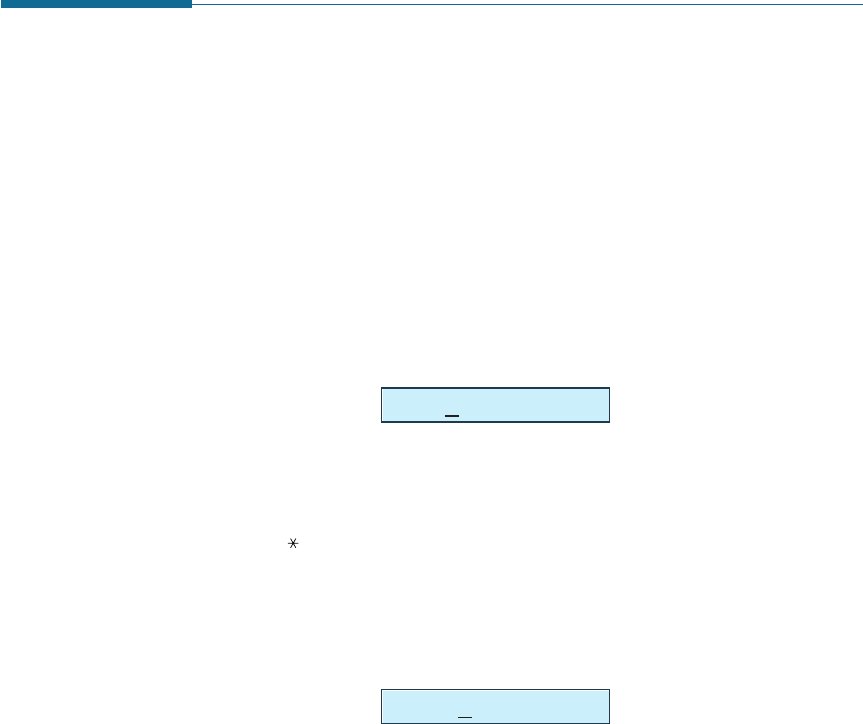
1.19
Getting Started
Setting Your Fax Number and Name
Your fax number and name can be printed at the top of each page
transmitted.
1. Press User Tools on the front panel. The display shows the first setup
menu; FAX NUMBER/NAME.
2. Press Start/Enter to access the Fax Number/Name menu.
The display shows ‘FAX NUMBER.’
3. Press Start/Enter.
If there is a number already set, the number appears.
4. Enter the telephone number your machine is connected to. You can
enter up to 20 digits.
Press for plus sign (+) and # for a hyphen. If you entered a wrong
number, press Search/Delete to delete it.
5. Press Start/Enter when the number on the display is correct.
If there is a name already set, the name appears.
6. Enter your name using number keypad. You can enter up to 40
characters.
For details on how to use the number keypad to enter alphanumeric
characters, see page 2.19.
7. Press Start/Enter when the name on the display is correct.
TEL:
NAME:
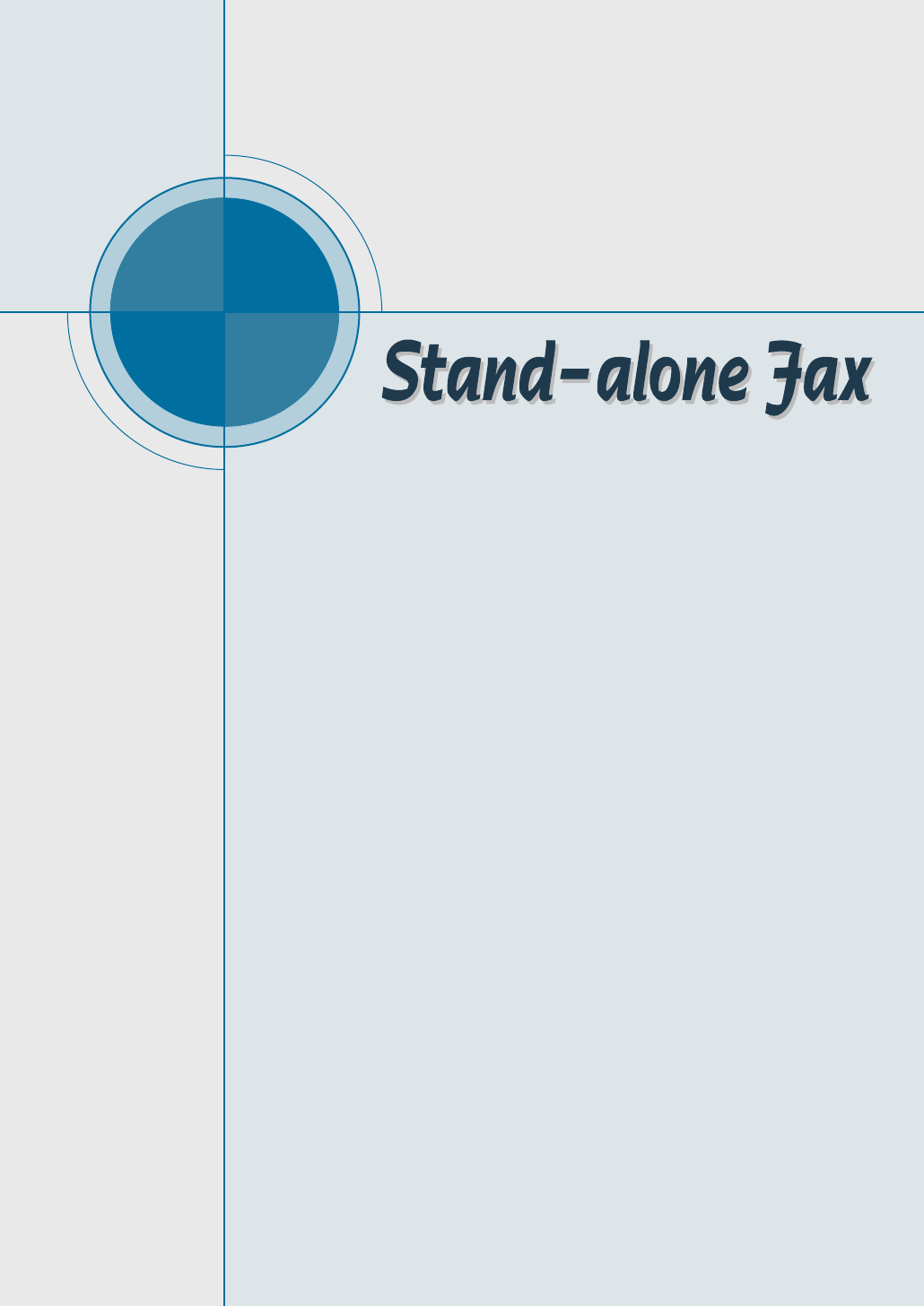
chapter
2
2
This chapter explains how to send and receive faxes from
the front panel of this machine. This chapter also
demonstrates how to use the Transmission Option features
and change the settings on the fax system.
This chapter provides information on the following topics:
◆Setting Up Stand-alone Fax System
◆Sending a Fax
◆Receiving a Fax
◆Making a Copy
◆Automatic Dialling
◆Transmission Options
◆Additional Functions

2.1
Stand-alone Fax
Setting Volume
Ringer Volume
You can adjust the volume of the ringer to your desired volume.
1. Press ➛or ❿in Standby mode.
The display shows the current ringer volume setting.
2. Press ➛or ❿until you find the desired loudness. Four levels are
available; 0~3.
You will hear the selected volume and the display will show the level.
Setting ‘0’ turns the ringer off. The machine will work normally even if
the ringer is set to off.
3. Press Start/Enter to save the setting.
Speaker Volume
1. Press On Hook Dial to adjust the speaker volume. If you cannot hear
dial tone, check the phone line connection.
2. Press ➛or ❿repeatedly until you find the desired loudness.
The display shows the current volume level.
3. After choosing the desired volume level, press On Hook Dial.
Setting up Stand-
alone Fax System
RINGER VOL.[3]
SPEAKER VOL.[2]

2.2 Stand-alone Fax
Setting Alert Tones
You can choose an alarm tone to sound when an error occurs (ALARM
VOLUME) or when any key is pressed (KEY VOLUME).
1. Press User Tools on front panel. The display shows the first setup
menu; FAX NUMBER/NAME.
2. Press ➛or ❿until ‘VOLUME SETUP’ appears, then press Start/Enter.
The display shows ‘ALARM VOLUME’.
3. Press Start/Enter to access the Alarm Volume menu. To access the
Key Volume menu, press ➛or ❿until ‘KEY VOLUME’ appears, then
press Start/Enter.
4. Press ➛or ❿to turn the sound ON or OFF, then press Start/Enter
to save the setting.
5. To return to Standby mode, press Stop.
Setting User-Selectable System Options
Your machine has various user-selectable system options. These options
are preset at the factory but you may need to change them. To find out
how the options are currently set, print the System Data list. For more
information on printing the list, see above.
Setting an Option
1. Press User Tools on the front panel. The display shows the first
menu; FAX NUMBER/NAME.
2. Press ➛or ❿until ‘SYSTEM SETUP’ appears. The display shows the
first option menu; LANGUAGE.
3. Scroll through the options by pressing ➛or ❿repeatedly.
4. When the option you want appears on the display, press
Start/Enter.
5. Choose the desired status by pressing ➛or ❿repeatedly, or enter
the desired value using the number keypad.
2.3
Stand-alone Fax
6. When setting is done, press Start/Enter to save the setting.
You can exit from setup mode at any time by pressing Stop. The
machine returns to Standby mode without saving the setting you
have already changed.
Selectable Options
These instructions assume you have followed the steps on page 3.1
under ‘Setting an Option’ and the machine is prompting you to change
one of the options listed here.
• LANGUAGE — You can select the display language. The available
languages are ENGLISH, GERMAN, FRENCH, ITALIAN, SPANISH,
PORTUGUESE and DUTCH.
• SEND FROM MEMORY—Enables all transmission documents to be
automatically scanned into the memory before transmission.
Select ON to enable.
Select OFF to disable.
• SENDING CONFIRM — A confirmation report shows whether the last
transmission was successful or not, how many pages were sent, etc.
Select ERROR to print only when an error occurs and the transmission
was not successful.
Select ON to print a confirmation report automatically each time you
send a fax.
Select OFF to turn off.
• FAX PAPER SIZE — Select the paper size you will use for recording.
LETTER, A4 and LEGAL sizes are available.
Note: If you set the Auto Reduction menu option, or turned Paper
Save mode on, your machine will determine the reduction rate
according to this setting.
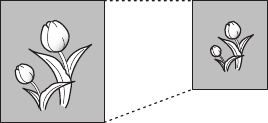
2.4 Stand-alone Fax
• AUTO REDUCTION — When receiving a document as long or longer
than the paper loaded in your machine, the machine can reduce the
data in the document to fit into your recording paper size.
Turn this feature on to reduce an incoming page that may need to be
divided into two pages with only a few lines on the second page. If the
fax machine cannot reduce the data to fit onto one page with this
feature enabled, the data will be divided and printed in actual size on
two or more sheets if necessary.
Select ON to enable. Note that this feature does not apply to the copy
mode.
Select OFF to turn this feature off. The overflow data will be printed
out on a second page.
• DISCARD SIZE — When receiving or copying a document as long as
or longer than the paper installed in your machine, you can set the
machine to discard any excess image at the bottom of the page to fit
onto the recording paper size.
Enter the desired discard size from 0 through 30 mm using the
number keypad.
If the received page is outside the margin set, it will be printed on two
sheets of paper at the actual size.
If the data is within the margin, and the Auto Reduction feature is on,
it will be reduced to fit onto the appropriate size paper (Discard does
not take place). If the Auto Reduction feature is turned OFF or fails,
the data within the margin will be discarded.
• RINGS TO ANSWER —You can select the number of times your
machine rings before answering an incoming call. If you are using your
machine as both a telephone and a fax machine, we suggest you set
the ring count to at least 4 to give you time to answer.
Original Received data
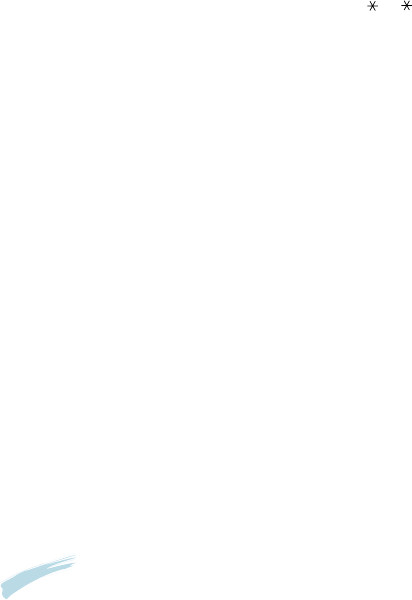
2.5
Stand-alone Fax
• STAMP RCV. NAME—Allows the machine to automatically print the
page number, and the date and time of the reception at the bottom of
each page of a received document.
Select ON to enable.
Select OFF to disable.
• RCV. START CODE — The remote receive start code allows you to
initiate fax reception from an extension phone plugged into the EXT.
jack on the back of your machine. If you pick up the extension phone
and hear fax tones, enter the remote code and the machine will start
receiving. The password is preset to ‘ 9 ’ at the factory.
Enter the desired code 0 to 9 on the number keypad.
• ECM MODE (Error Correction Mode) — This mode compensates for
poor line quality and ensures accurate, error-free transmission with
another ECM-equipped facsimile machine. If the line quality is poor,
transmission time may be increased when the ECM is enabled.
Select ON to enable.
Select OFF to disable.
• JUNK FAX BARRIER — With this feature set to ON, the system will
only accept a fax sent from the remote station of which the fax
number is stored in memory as a one-touch or two-digit speed dial
number. This feature is useful for blocking any unwanted fax.
Select ON to turn this feature on. You can receive only from the
registered stations.
Select OFF to turn this feature off. Anybody can send you a fax.
Notes:
• This feature needs the number reported by the remote fax to be an exact
match to a one-touch or speed dial number in this machine.
If you have a problem receiving faxes, turn this feature off.

2.6 Stand-alone Fax
• DRPD MODE — “Distinctive Ring” is a telephone company service
which enables a user to use a single telephone line to answer several
different telephone numbers. The particular number someone uses to
call you on is identified by different ringing patterns, which consist of
various combinations of long and short ringing sounds. This feature is
often used by answering services who answer telephones for many
different clients and need to know which number someone is calling in
on to properly answer the phone.
Using the Distinctive Ring Pattern Detection feature, your fax machine
can “learn” the ring pattern you designate to be answered by the FAX
machine. Unless you change it, this ringing pattern will continue to be
recognised and answered as a FAX call, and all other ringing patterns
will be forwarded to the extension telephone or answering machine
plugged into the EXT. jack.
You can easily suspend or change Distinctive Ring Pattern Detection at
any time.
Before using the Distinctive Ring Pattern Detection option, Distinctive
Ring service must be installed on your telephone line by the telephone
company. To setup Distinctive Ring Pattern Detection, you will need
another telephone line at your location, or someone available to dial
your FAX number from outside.
Select ON to turn this feature on.
Select OFF to turn this feature off.
Select SET to setup or change the Distinctive Ring Pattern Detection.
The LCD displays ‘WAITING RING’. Call your fax number from another
telephone. It is not necessary to place the call from a fax machine.
When your machine begins to ring, do not answer the call. The
machine requires several rings to learn the pattern.
When the machine completes learning, the LCD displays ‘END DRPD
SETUP’.
With the DRPD feature active, ‘DRPD’ appears in the display and the
previously set reception mode is ignored. If you turn off DRPD, the
machine returns to any previously set reception mode.
Notes:
• DRPD must be set up again if you re-assign your fax number, or
connect the machine to another telephone line.
• After DRPD has been set up, call your fax number again to verify that
the machine answers with a fax tone. Then have a call placed to a
different number assigned to that same line to be sure the call is
forwarded to the extension telephone or answering machine plugged
into the EXT. jack.
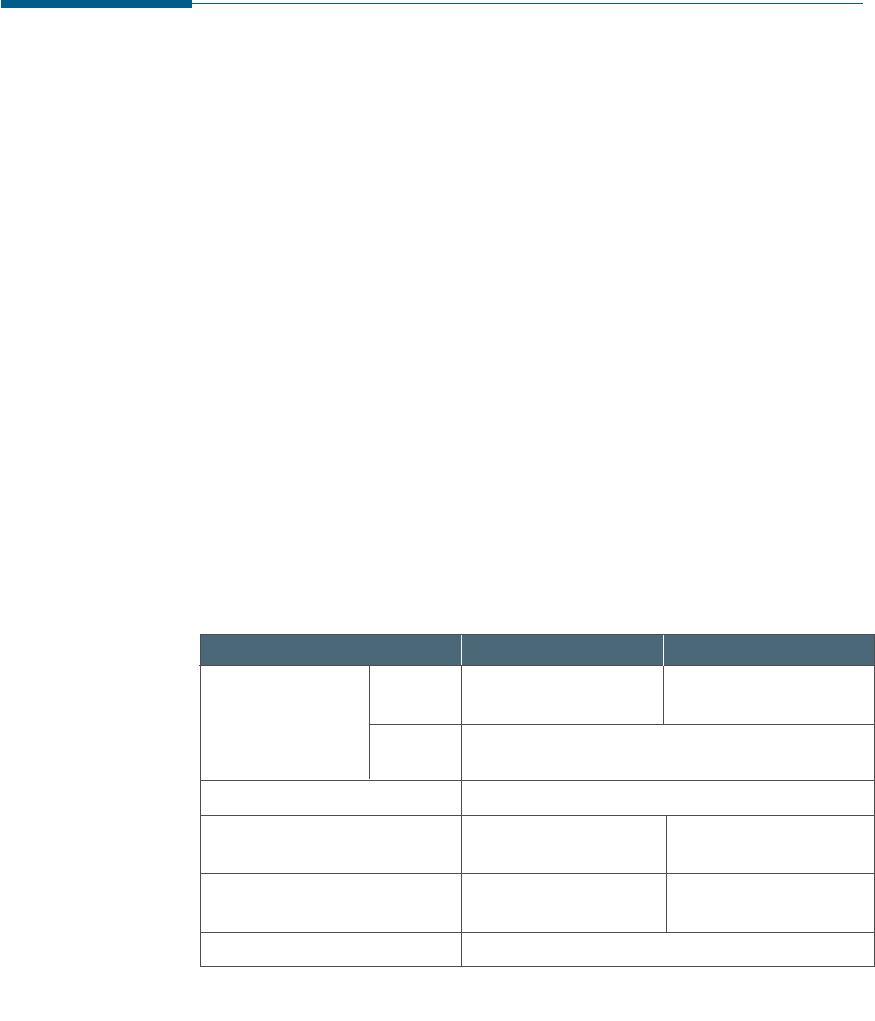
2.7
Stand-alone Fax
Preparing Documents for Faxing or Copying
To fax or copy documents that are printed on standard letter or A4 size
paper, follow these guidelines.
• Do not attempt to feed the following types of documents into the
machine: - wrinkled, curled, or folded paper
- chemically processed paper (pressure-sensitive paper,
carbon-coated paper, etc.)
- coated paper (glossy, etc.)
- thin paper (onion skin, airmail paper, etc.)
- thick paper
- small or short paper (such as a label, voucher, etc.)
- paper made of cloth or metal
To feed any of these documents, make copies using a standard copy
machine and insert the copies into the document tray.
• Remove all staples and paper clips before feeding the document.
• Ensure any glue, ink, or correction fluid on the paper is completely dry
before feeding the document.
• Do not feed documents with pages that are different sizes or different
thicknesses.
ACCEPTABLE DOCUMENTS (for ADF1)
Sending a Fax
Effective Scanning Width
Number of sheets which can
be loaded at a time
Thickness of document
Print Quality
Document Size Max.
Min.
8.5 in. (W) x 11.7 in. (L)
(216 mm x 297 mm)
8.5 in. (W) x 14 in. (L)
(216 mm x 356 mm)
5.8 in. (W) x 5.0 in. (L)
(148 mm x 128 mm)
8.26 in. (210 mm)
Uncoated on both sides
Up to 20
0.05 mm ~ 0.07 mm
0.15 mm ~ 0.2 mm 0.075 mm ~ 0. 12 mm
Single Sheet
2 or More Sheets
1 ADF stands for Automatic Document Feeder. It allows you to stack original documents, which will
be faxed or copied one by one.

2.8 Stand-alone Fax
Setting Document Resolution and Contrast
We recommend sending documents printed using a typewriter, felt tip pen,
black ink, or laserwriter. The paper should be white or very light, and of
normal weight – not cardboard. Blue lines on a ruled pad do not fax well.
To send normal documents, there is no need to adjust the resolution and
the contrast.
To send documents with unusual contrast characteristics, including
photographs, adjust the resolution and contrast.
Resolution
To increase sharpness and clarity, press the Resolution button repeatedly
after loading a document until you find the desired mode. You can choose
between STANDARD, FINE, or SUPER FINE mode.
STANDARD (200X 100 dpi) works well for documents with normal sized
characters.
FINE (200 X 200 dpi) is good for documents containing small characters,
thin lines, or print from a dot-matrix printer.
SUPER FINE (300 X 300 dpi) works well for documents containing
extremely fine details. SUPER FINE works only if the remote machine also
has the SUPER FINE features.
Contrast
To compensate for the brightness or darkness of your document, press the
Rcv. Mode/Contrast button repeatedly after loading a document until
you find the desired mode. You can choose between NORMAL, DARKEN,
LIGHTEN, or PHOTO.
NORMAL works well for normal documents.
DARKEN works well for light print or faint pencil markings. The light
image and text on the document will be darker on the printed page.
LIGHTEN works well for dark print. The dark image and text on the
document will be lighter on the printed page.
PHOTO is used when faxing photographs or other documents containing
color or shades of gray. When you choose this mode, you should set the
resolution to FINE.
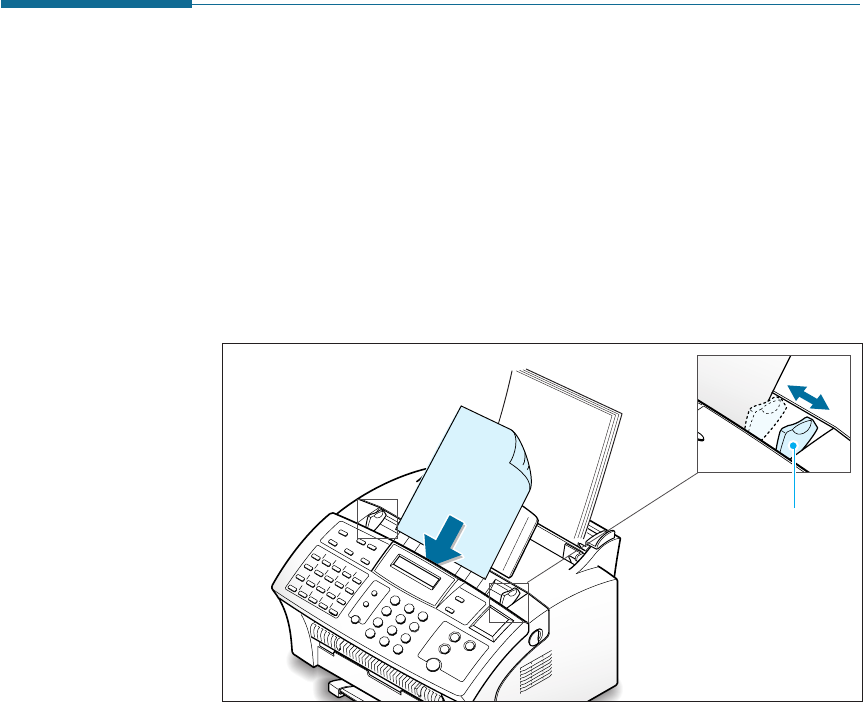
2.9
Stand-alone Fax
Loading Documents
1. Load your document face down with the top edge first going into the
document feeder.
2. Adjust the document guides for the width of the document.
3. Slide the sheet down into the document feeder until it is in the feed
area.
You can insert up to 20 sheets at a time. If you insert more than
one sheet, ensure the bottom sheet enters first. Stagger the leading
edge of the document slightly, and insert the document with a slight
push to ensure they feed smoothly.
To add pages while the fax is being sent, place them on top of the
already loaded sheets.
4. If necessary, use the Resolution and Rcv. Mode/Contrast buttons
to change the resolution and the contrast (see page 2.8).
Document guide